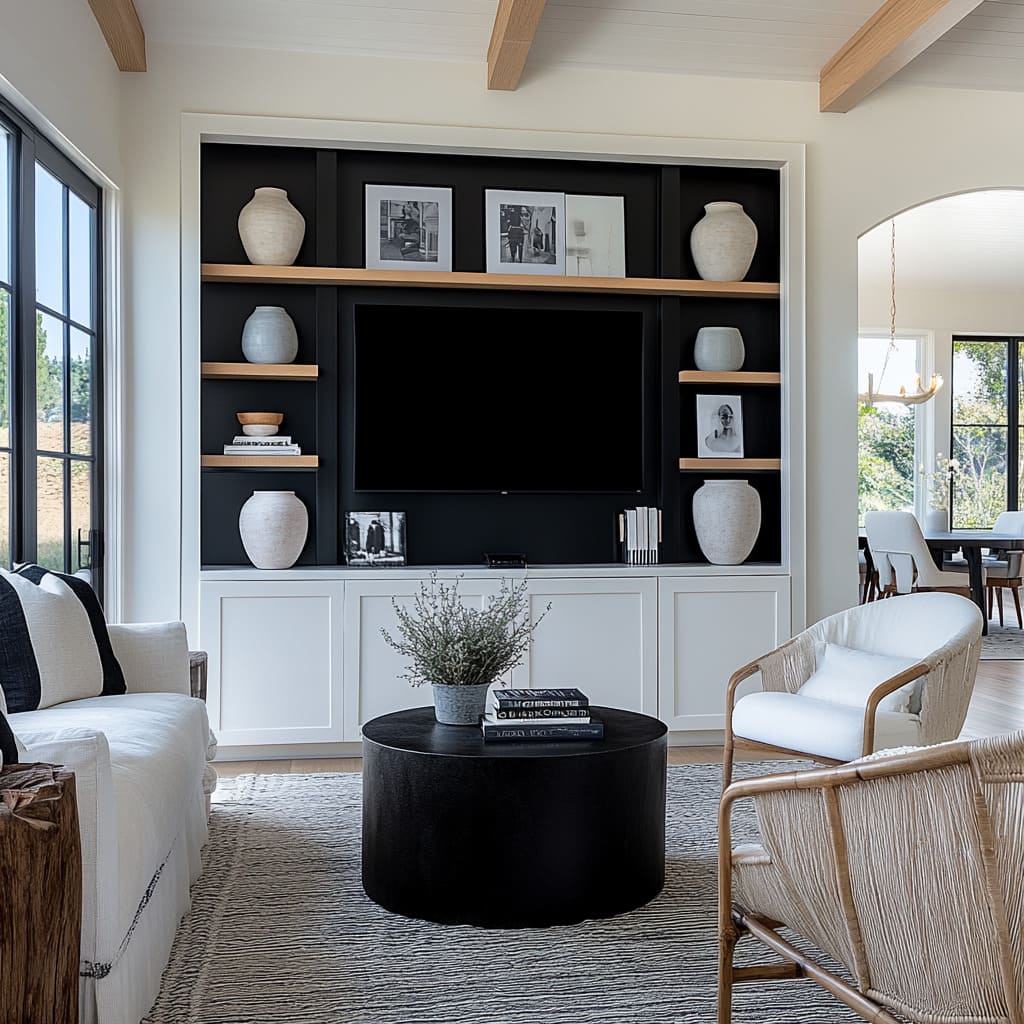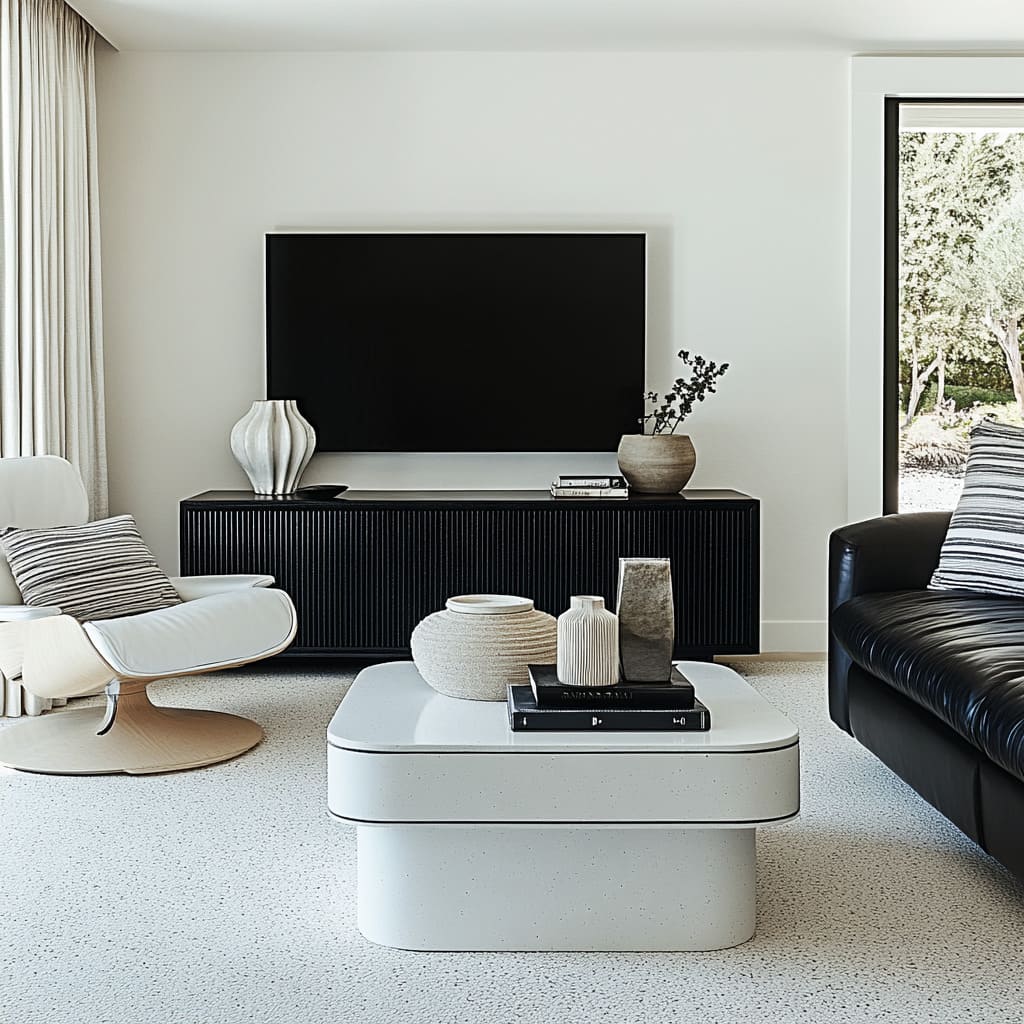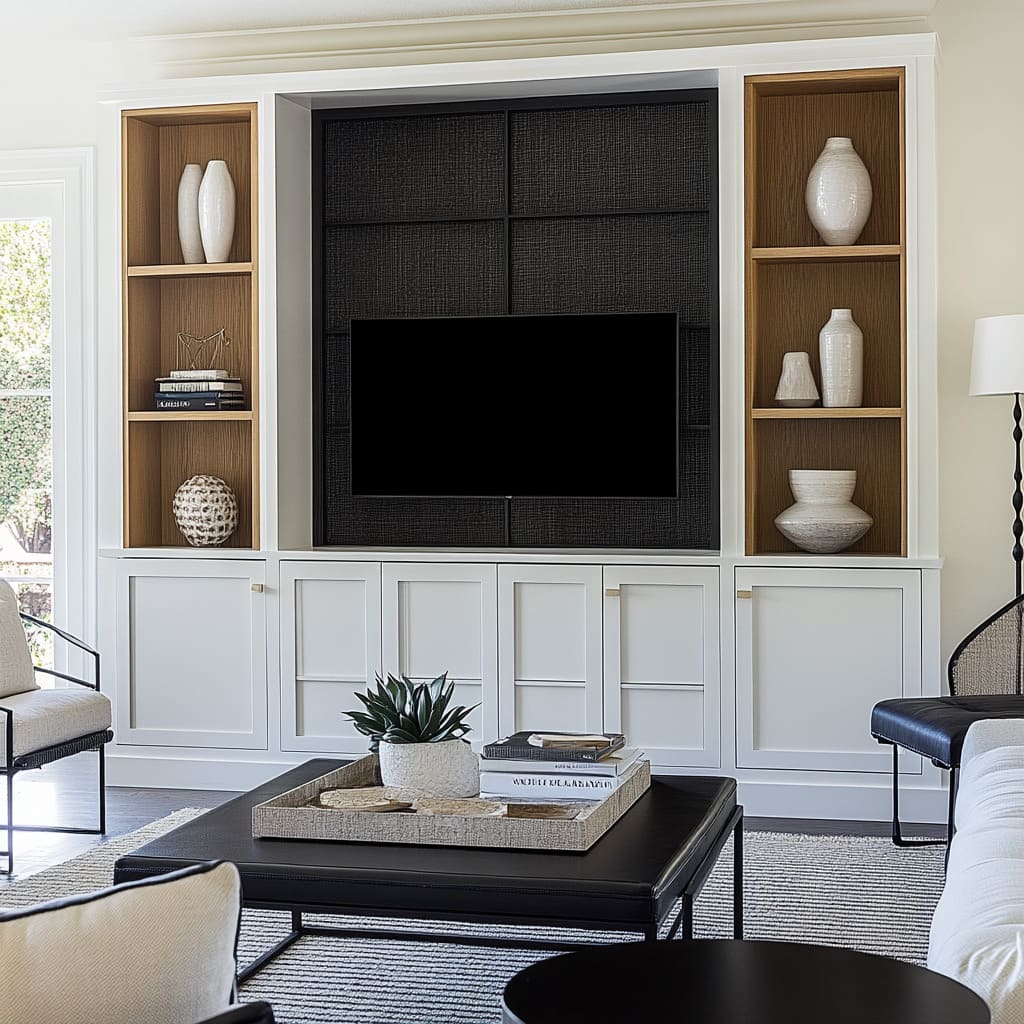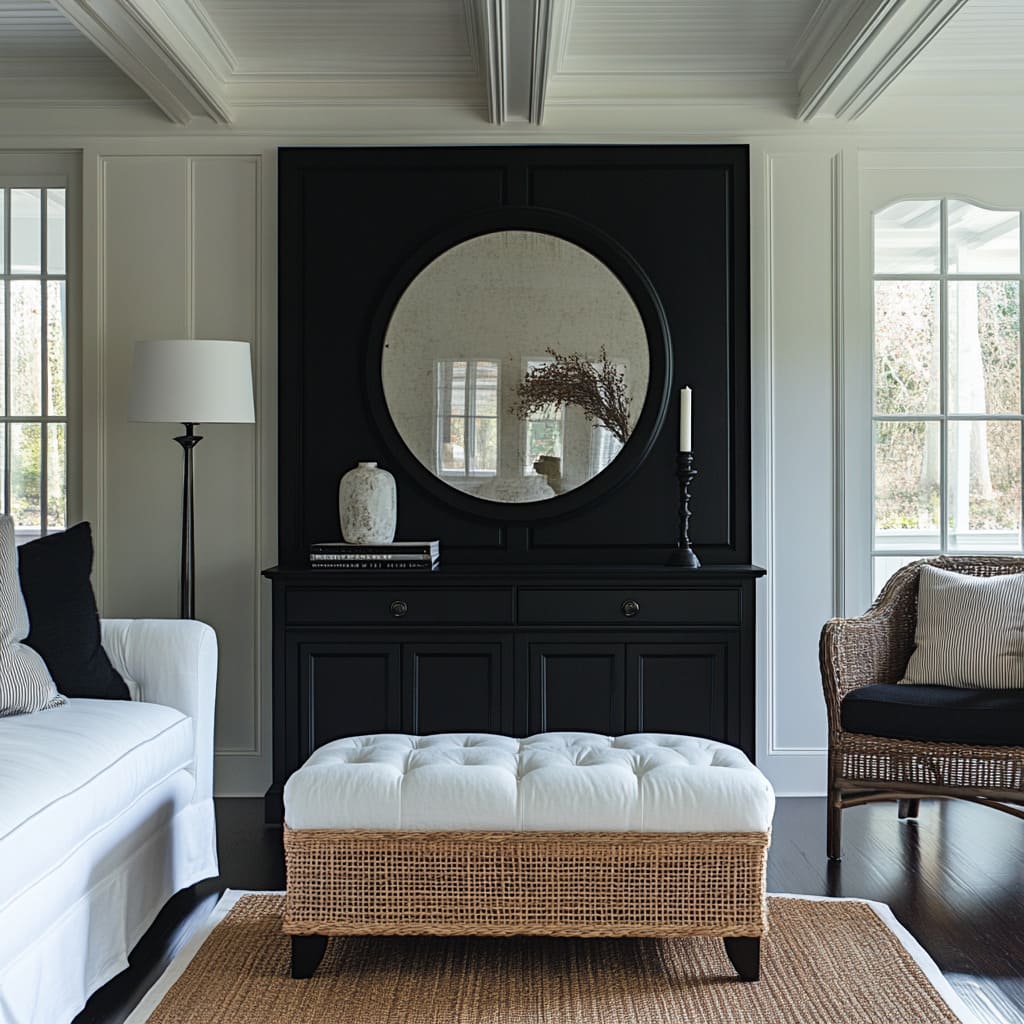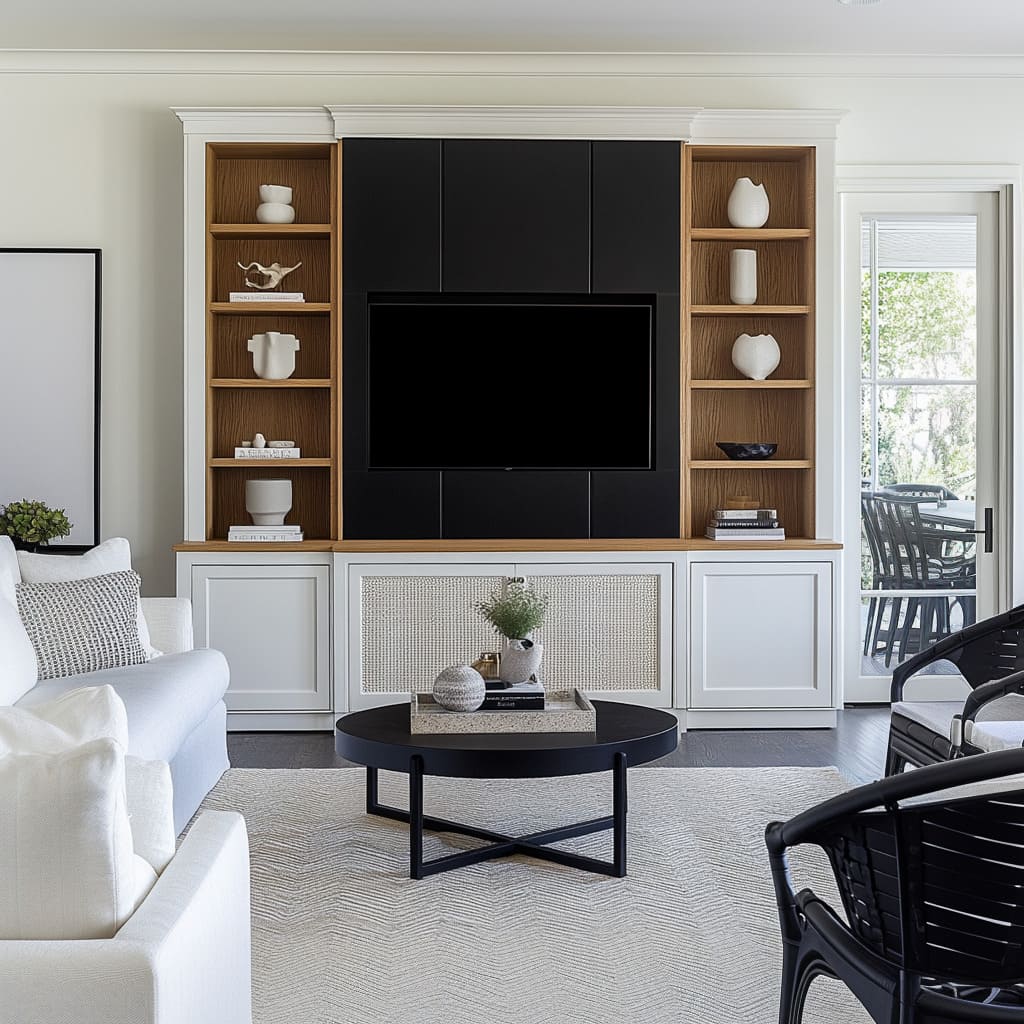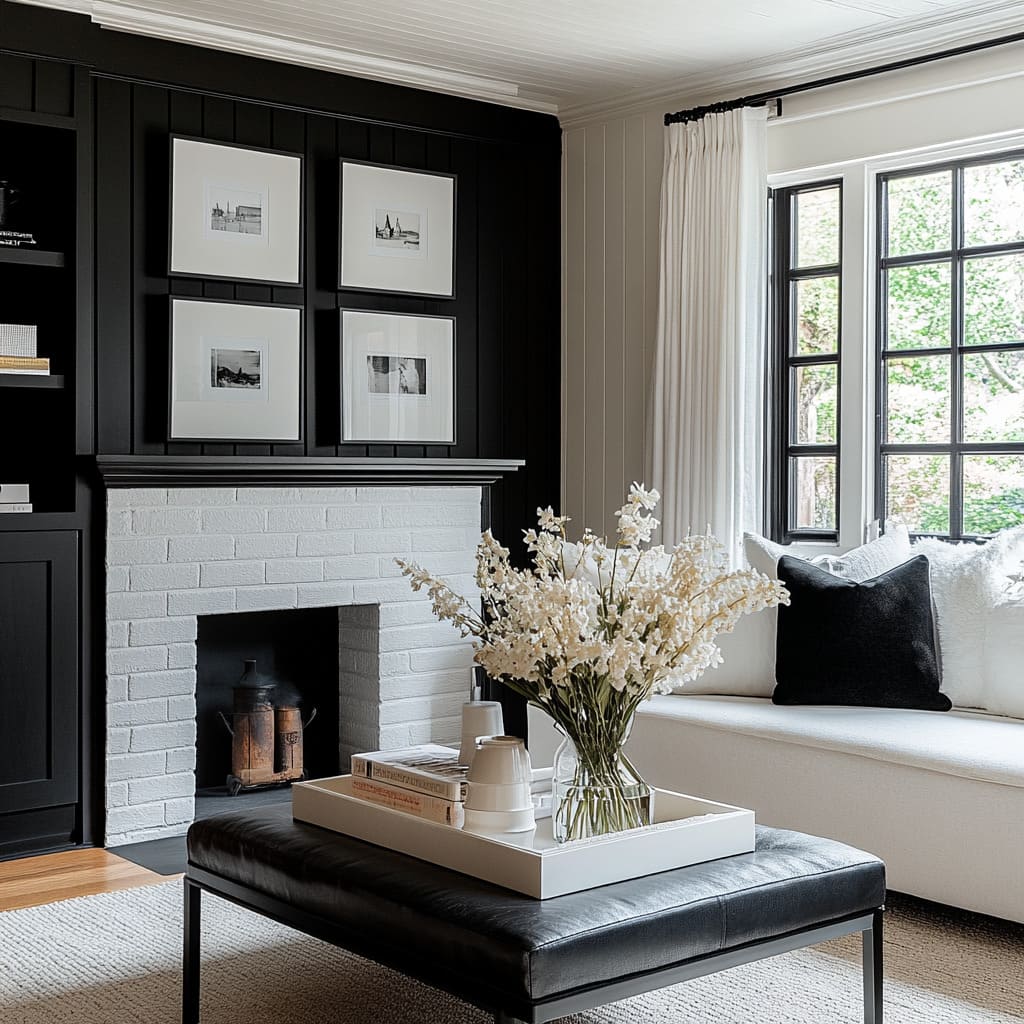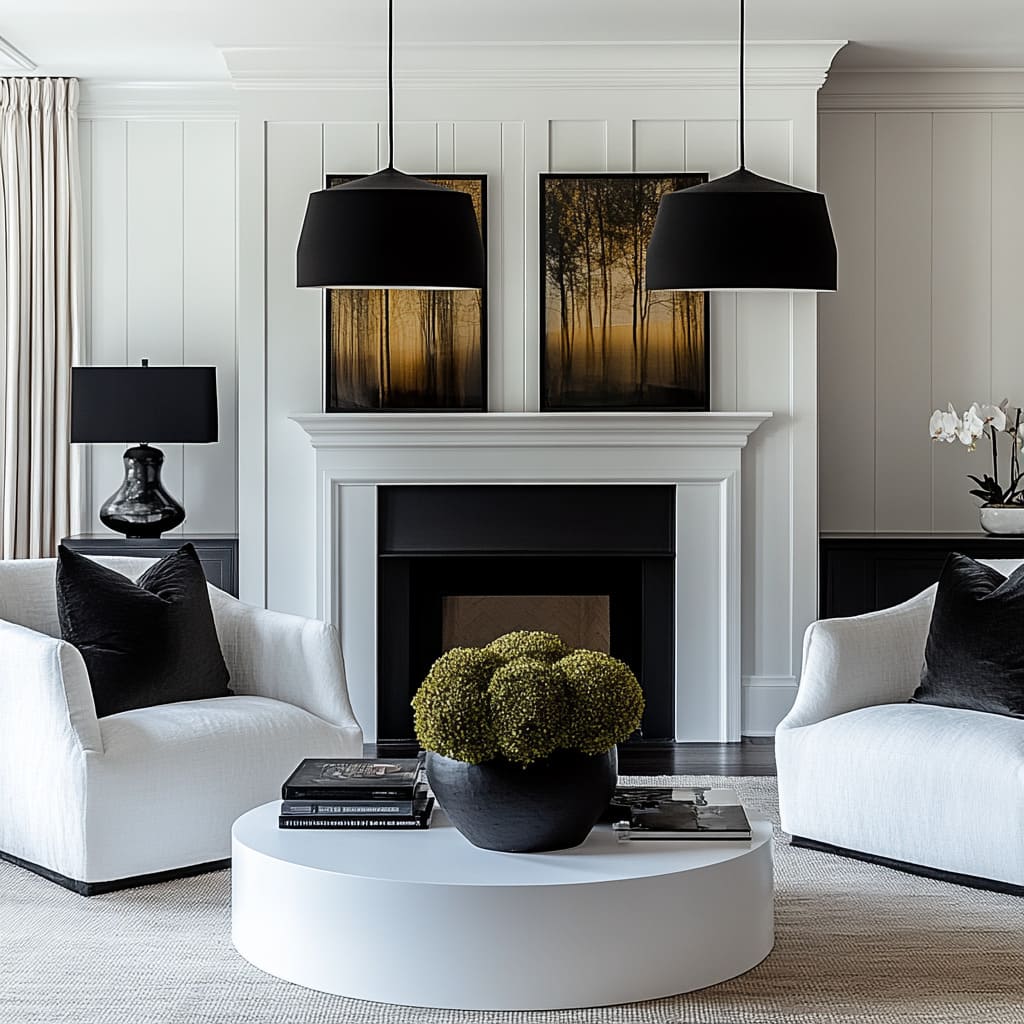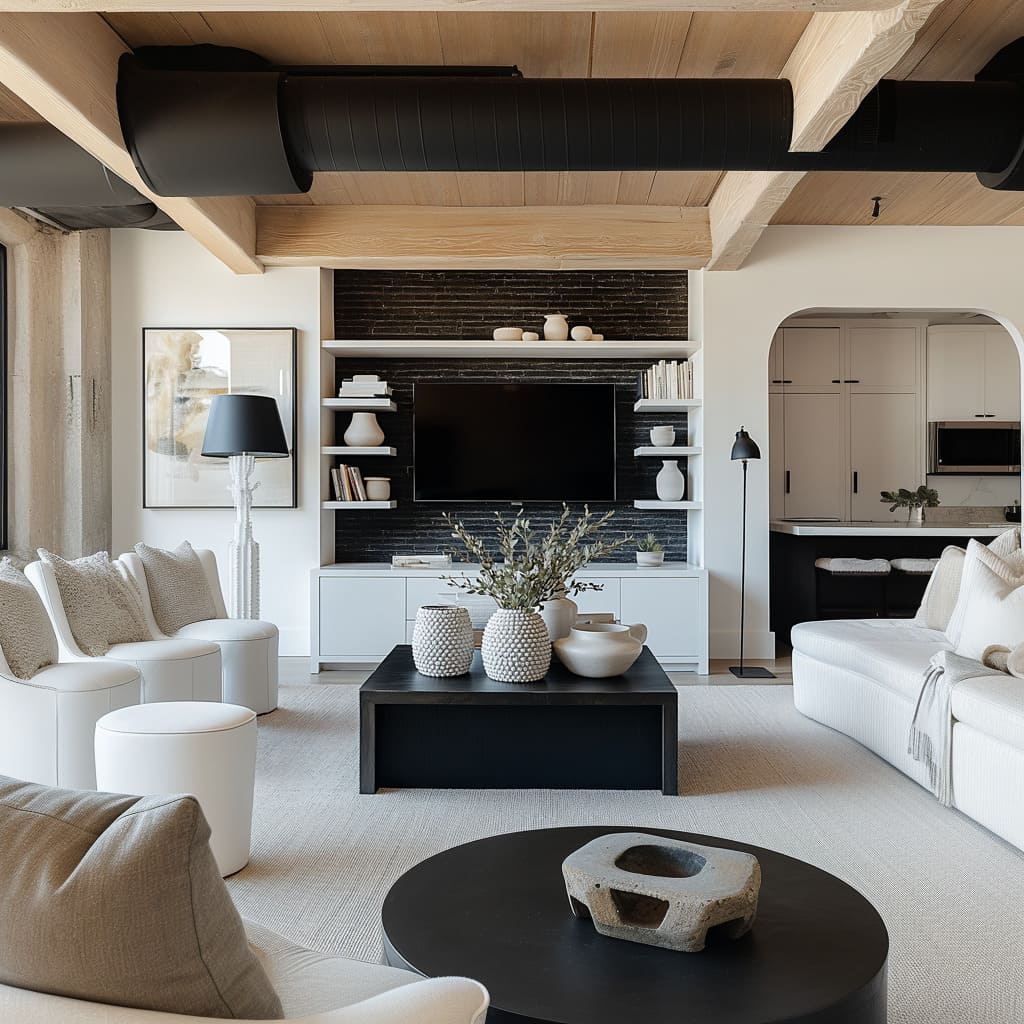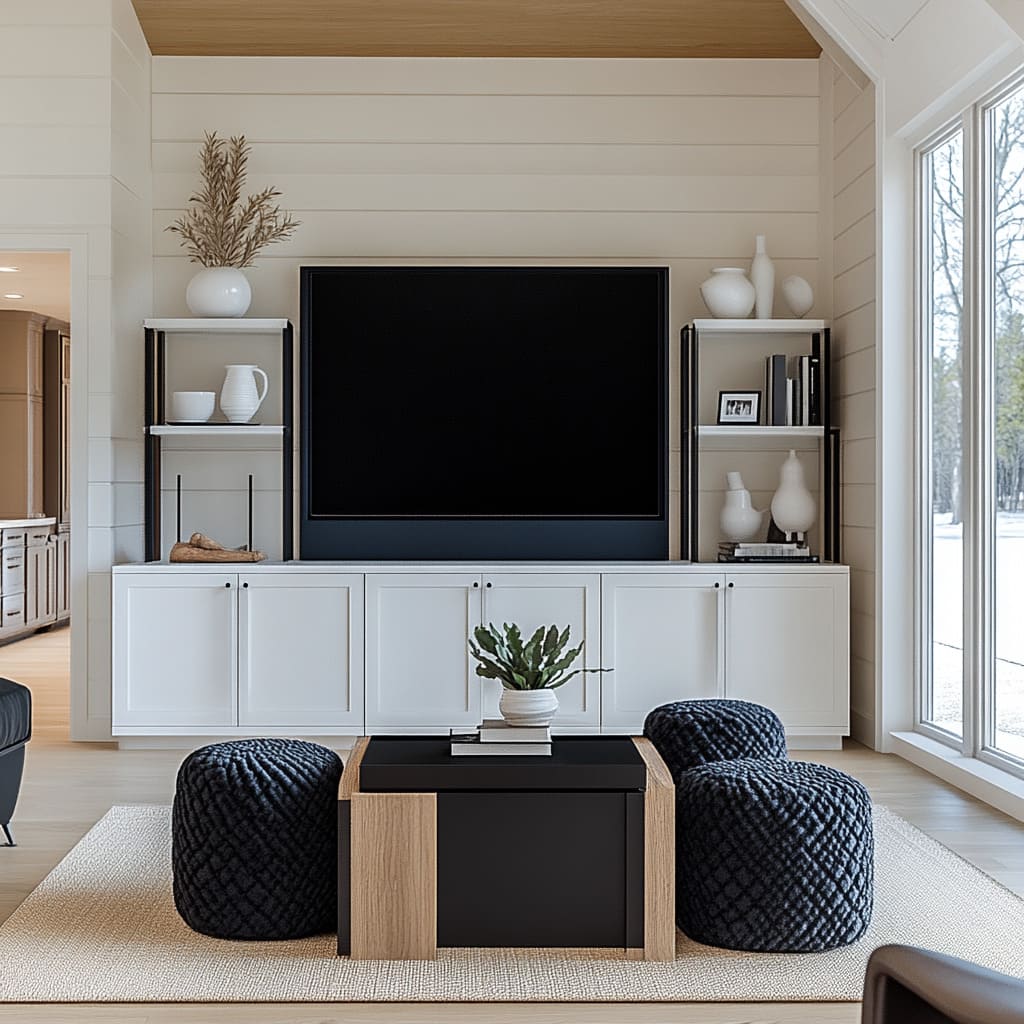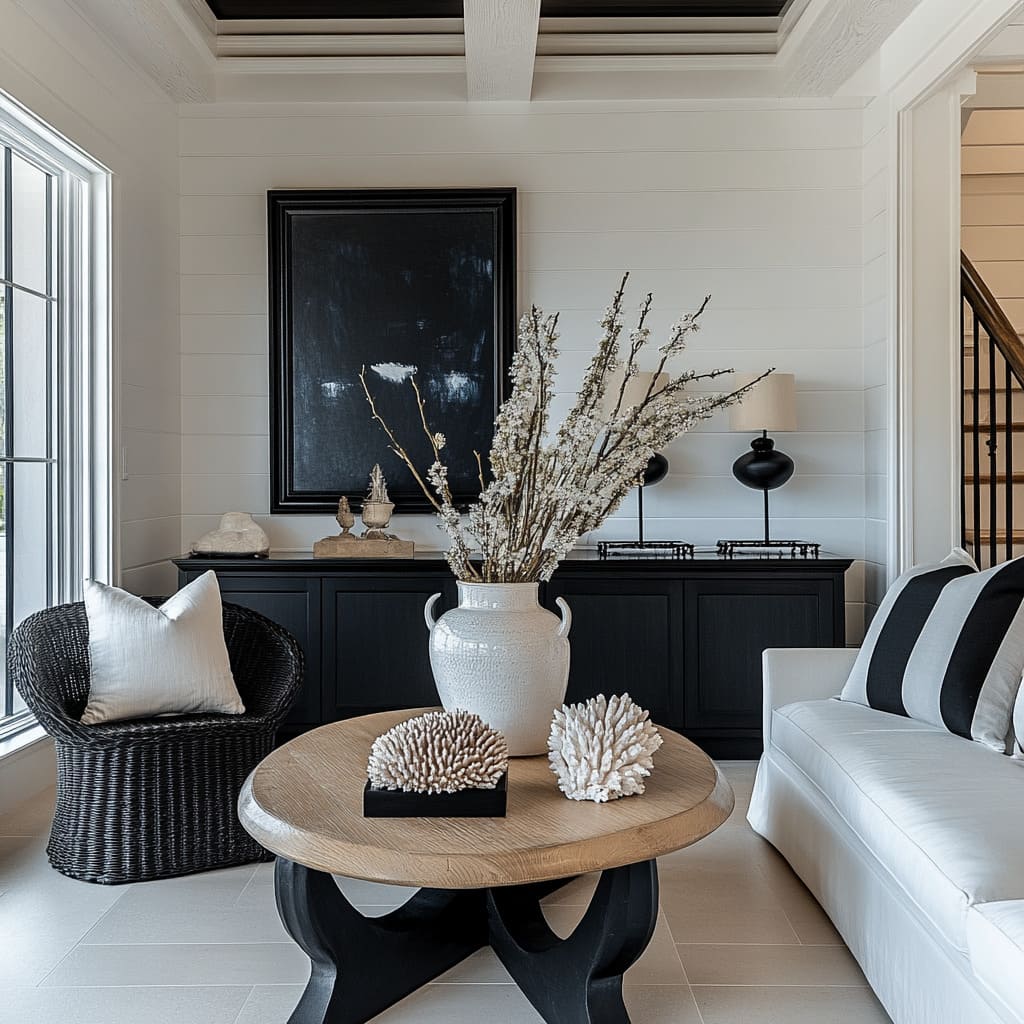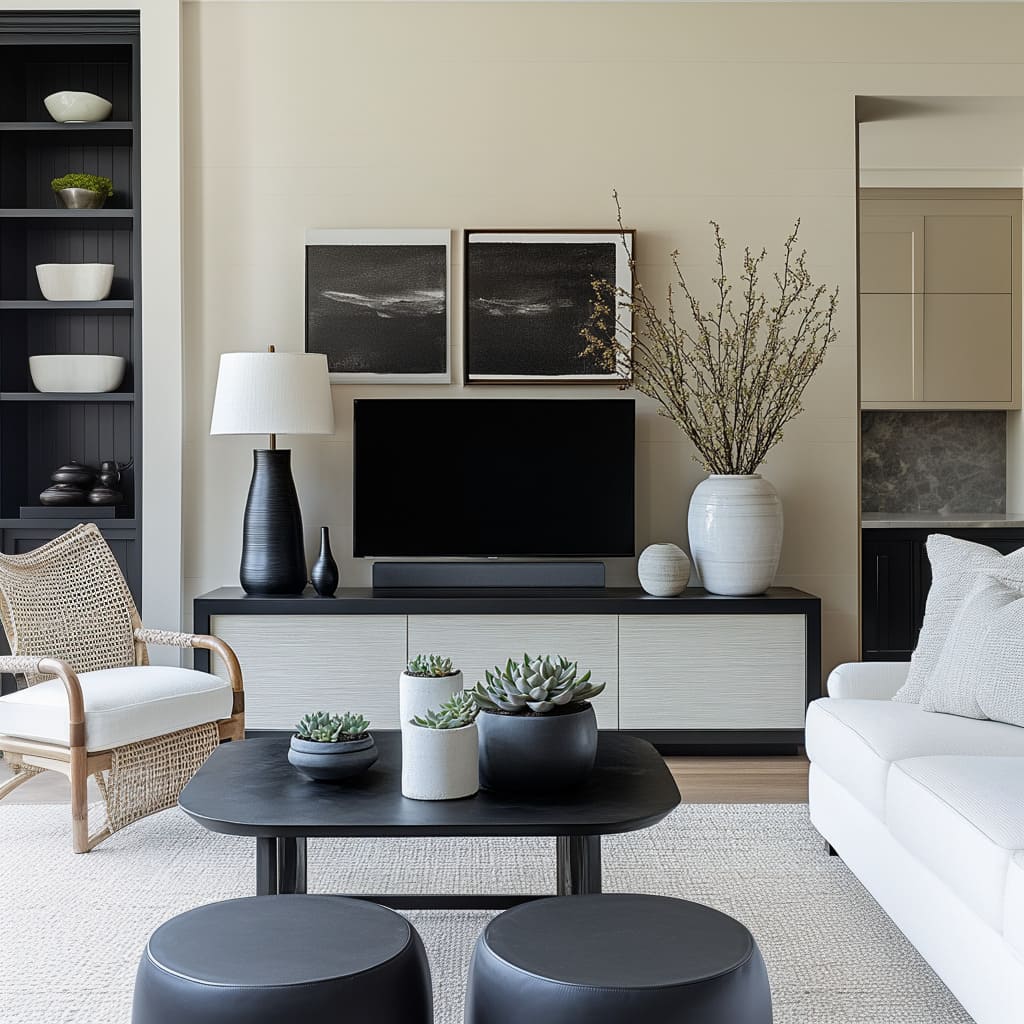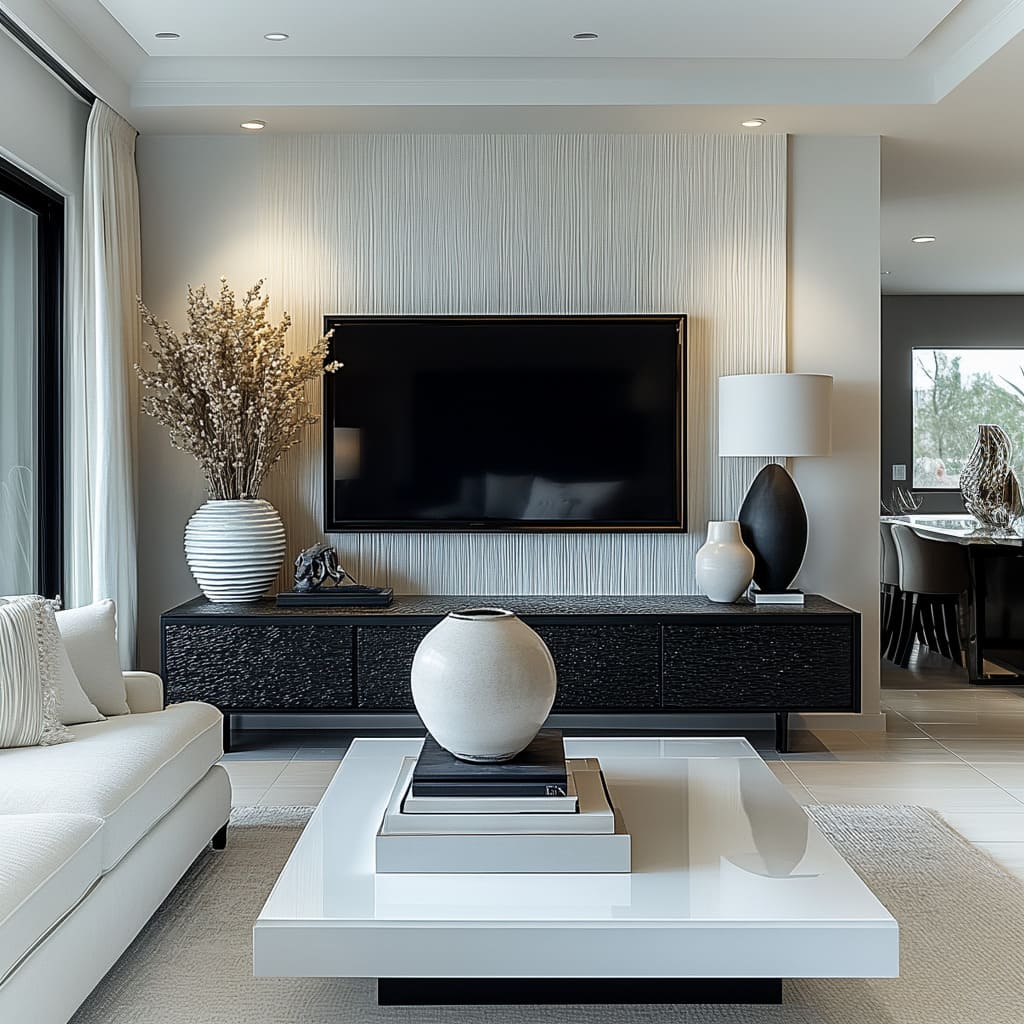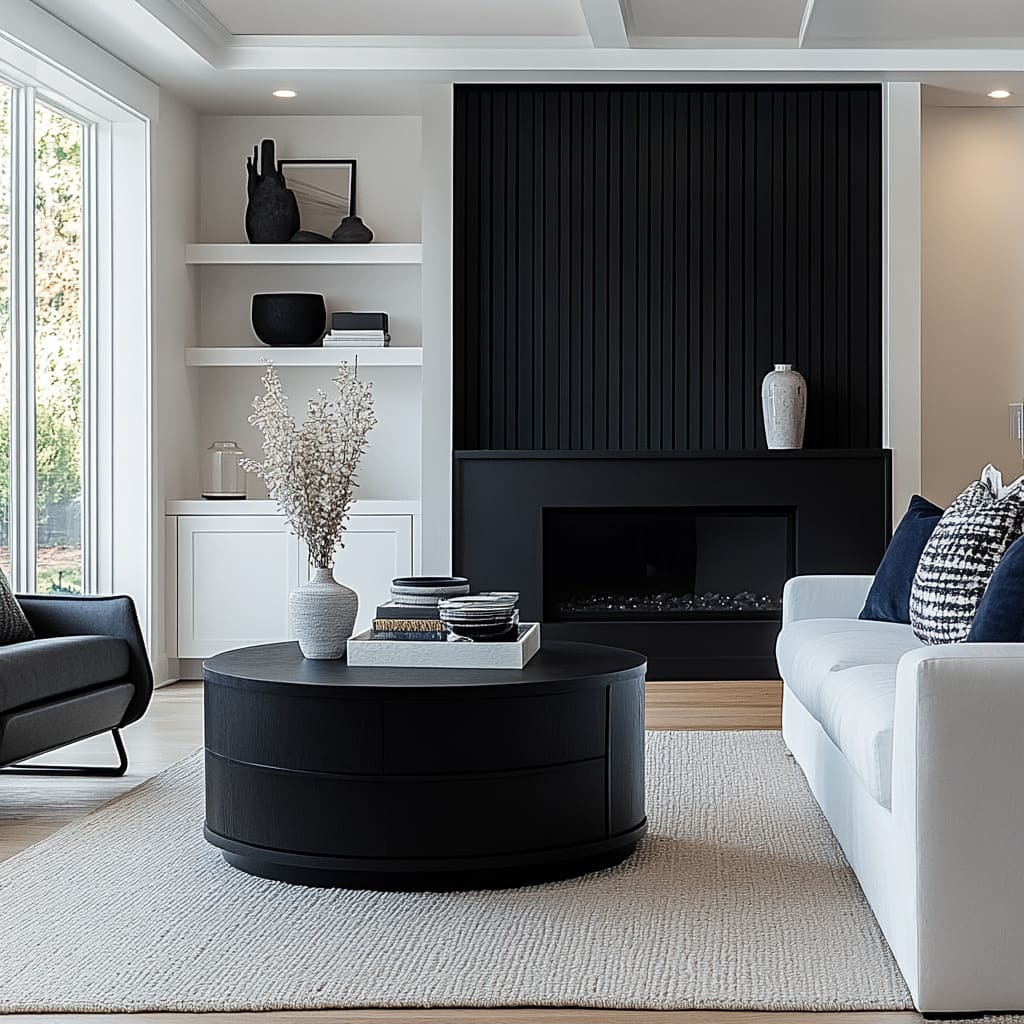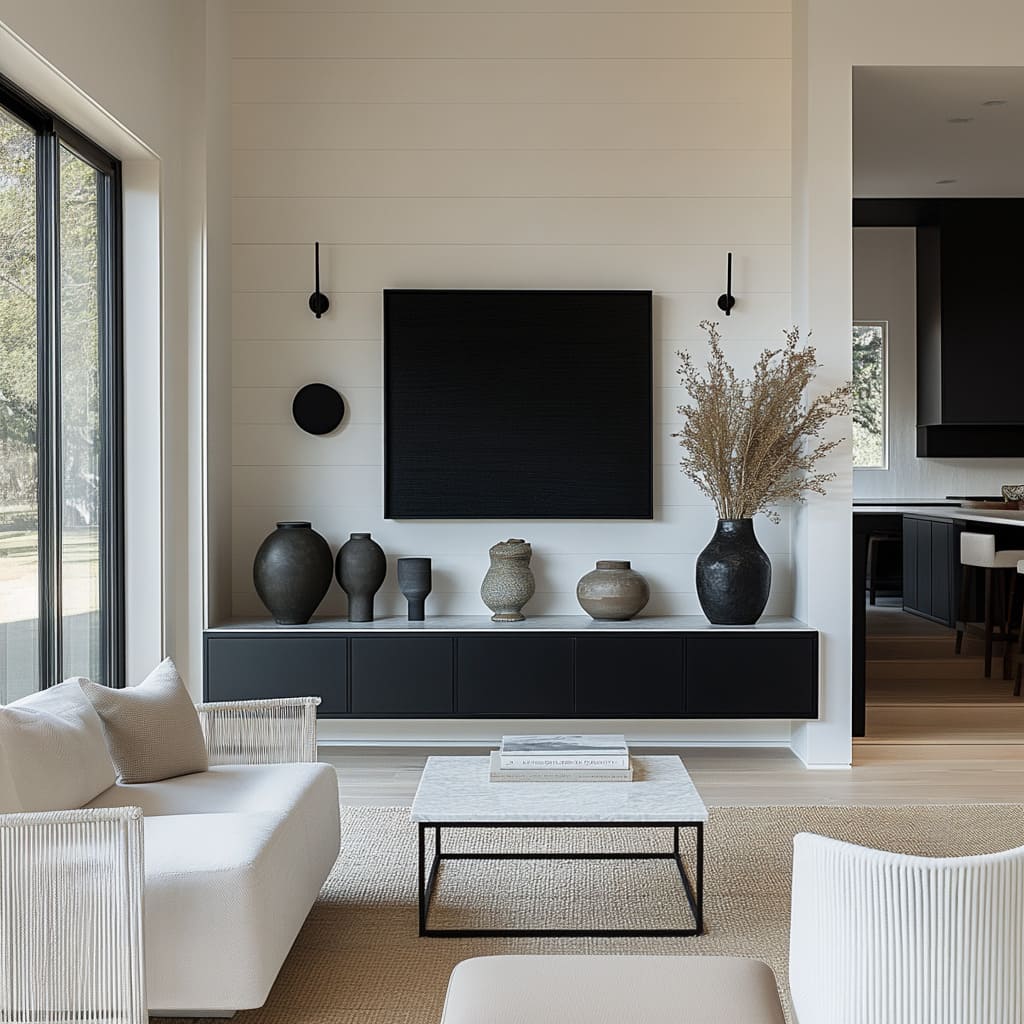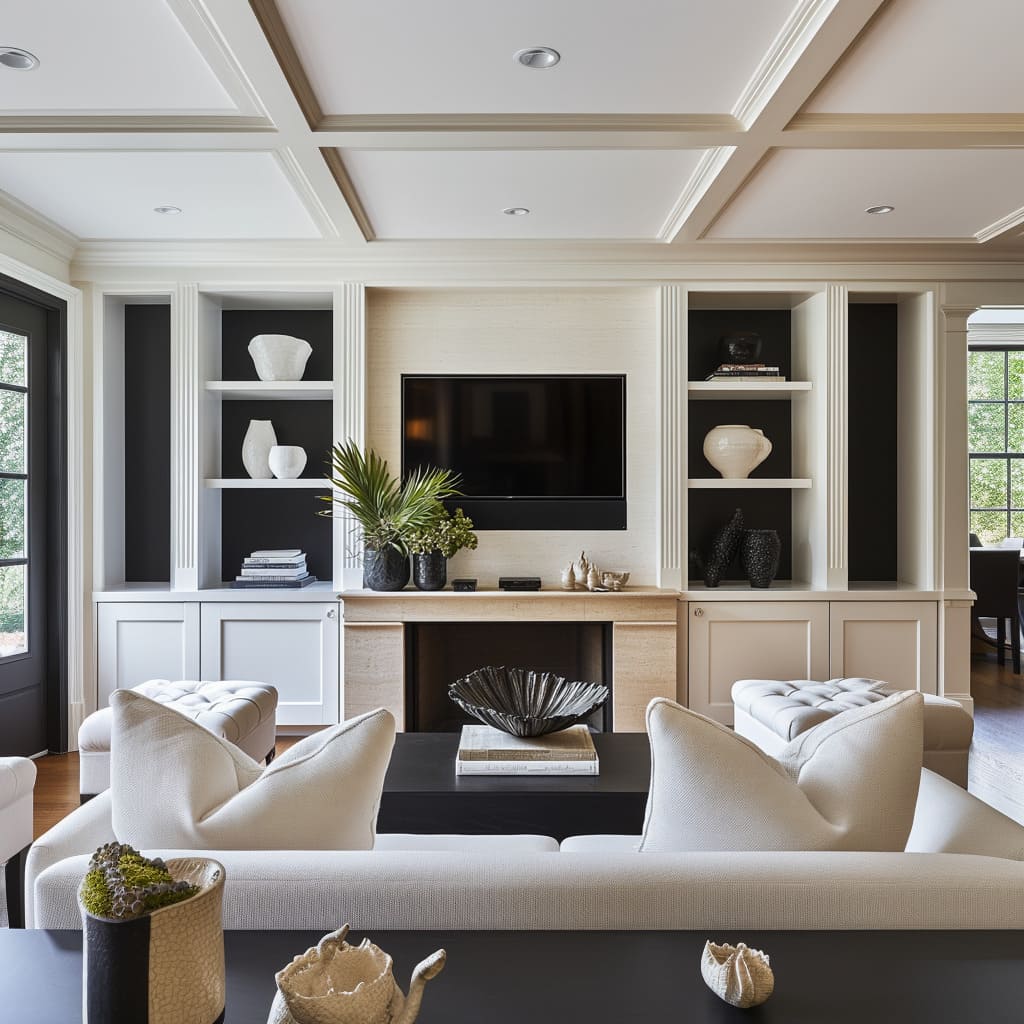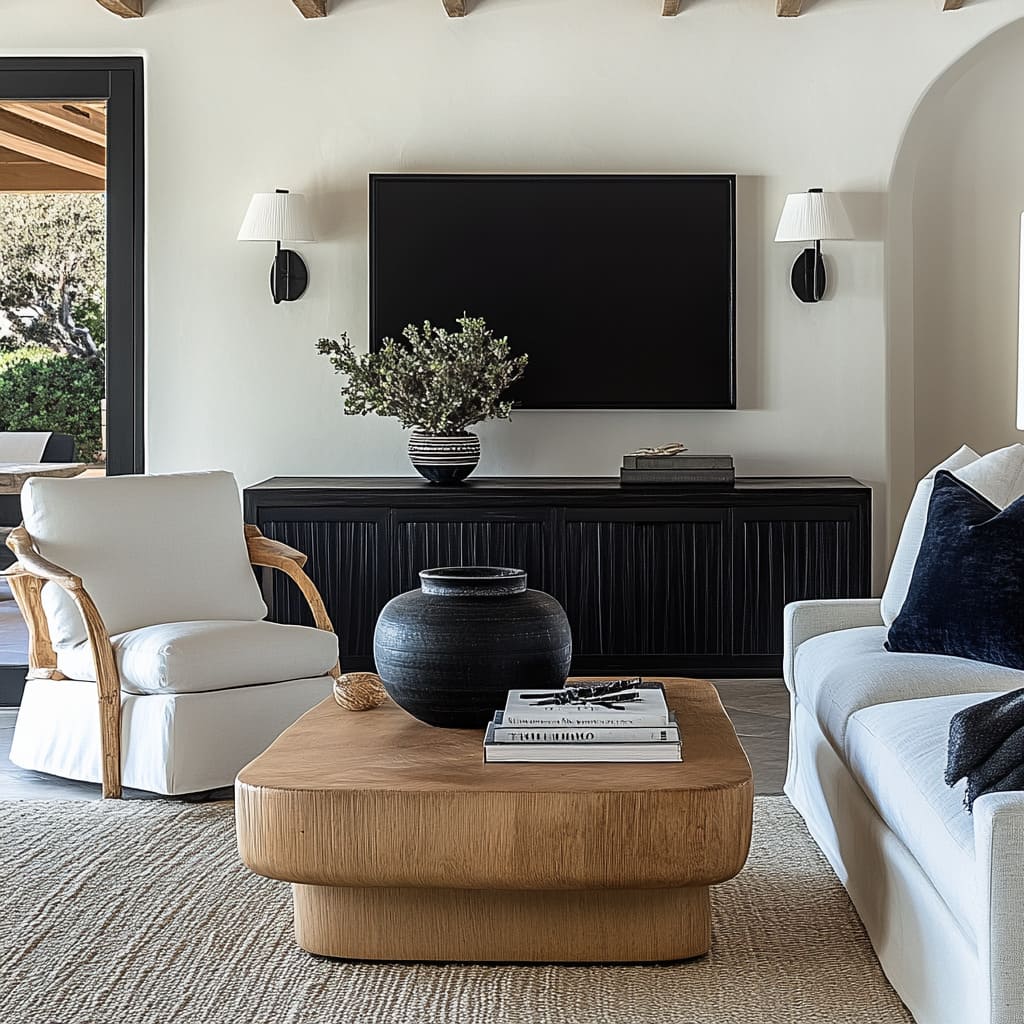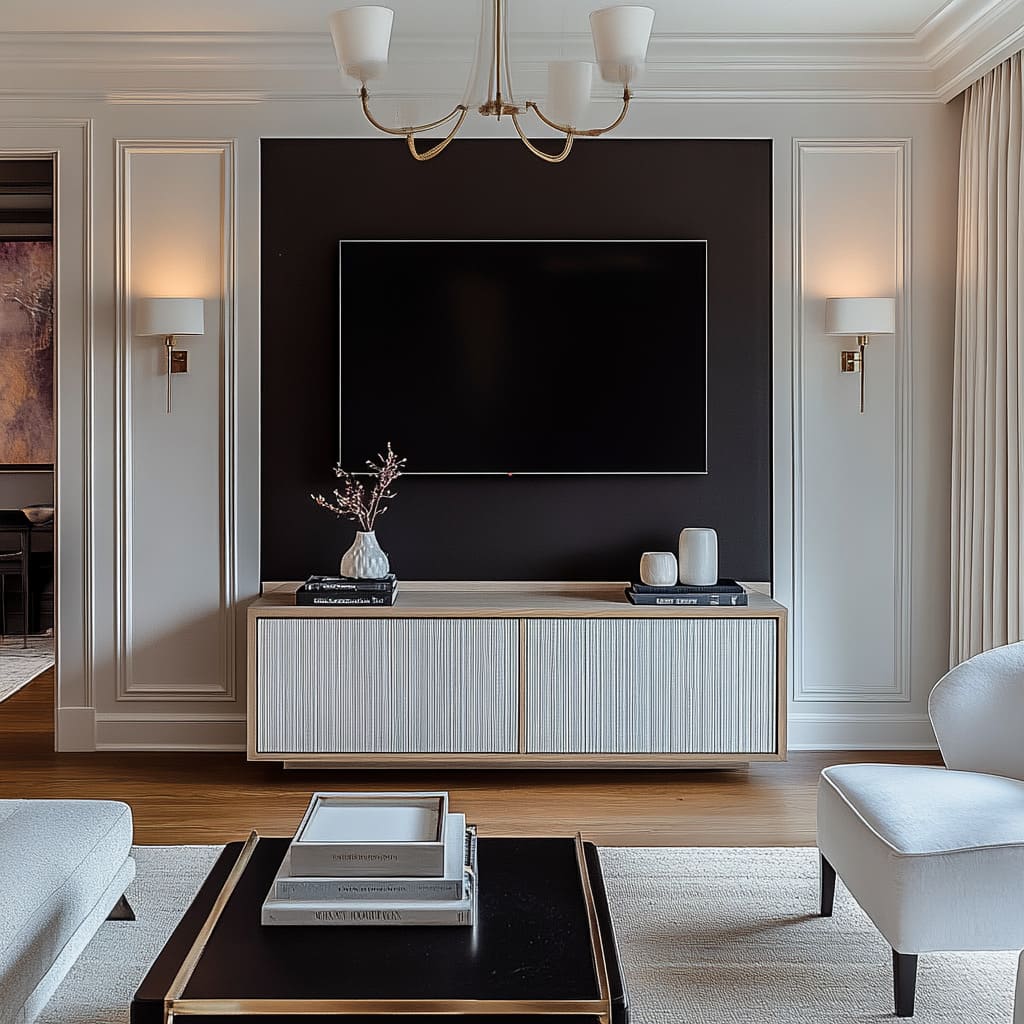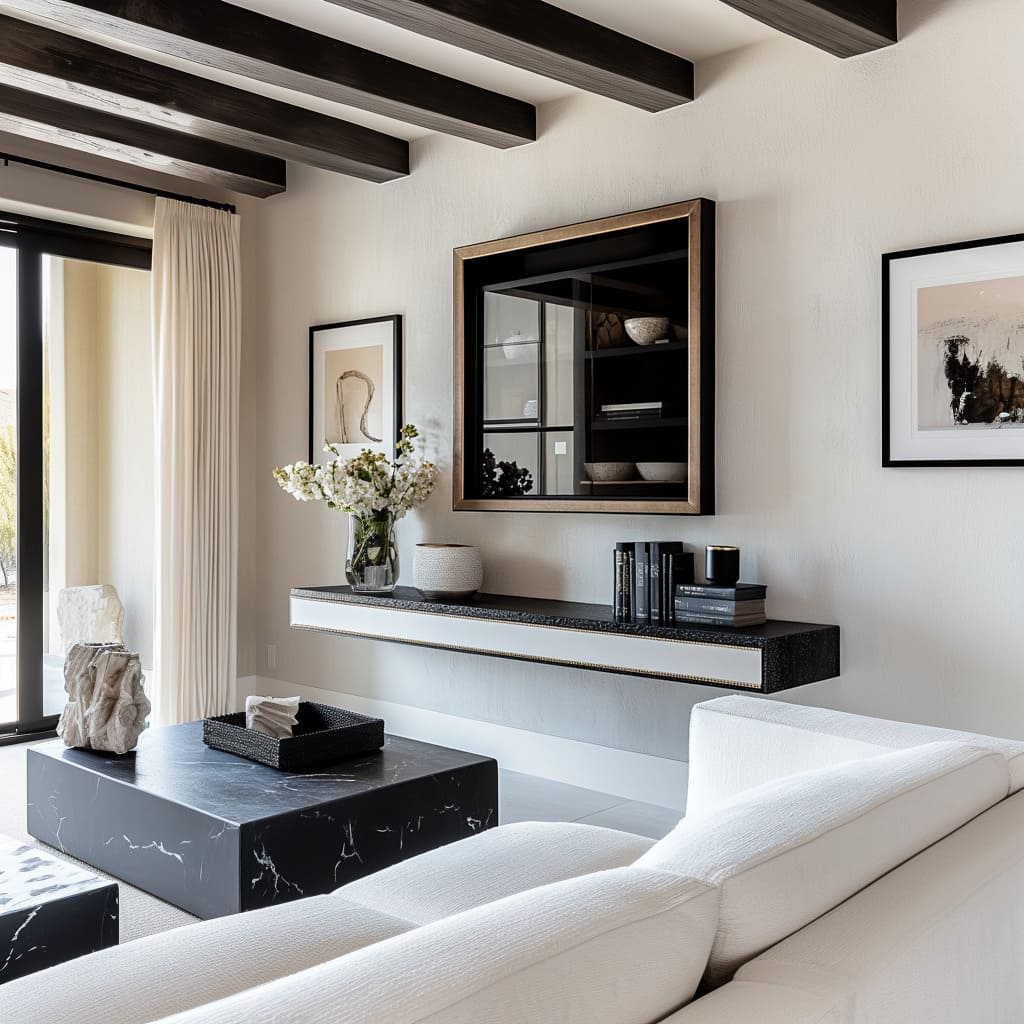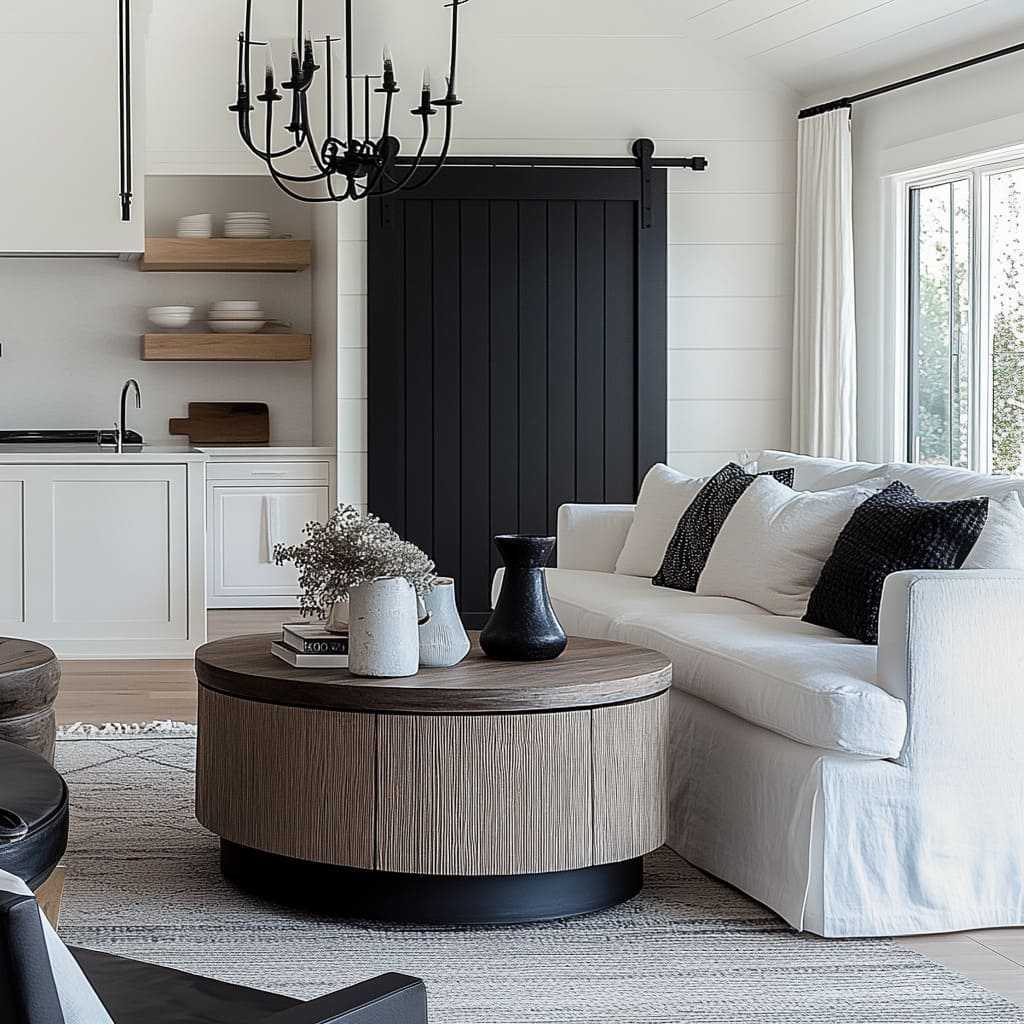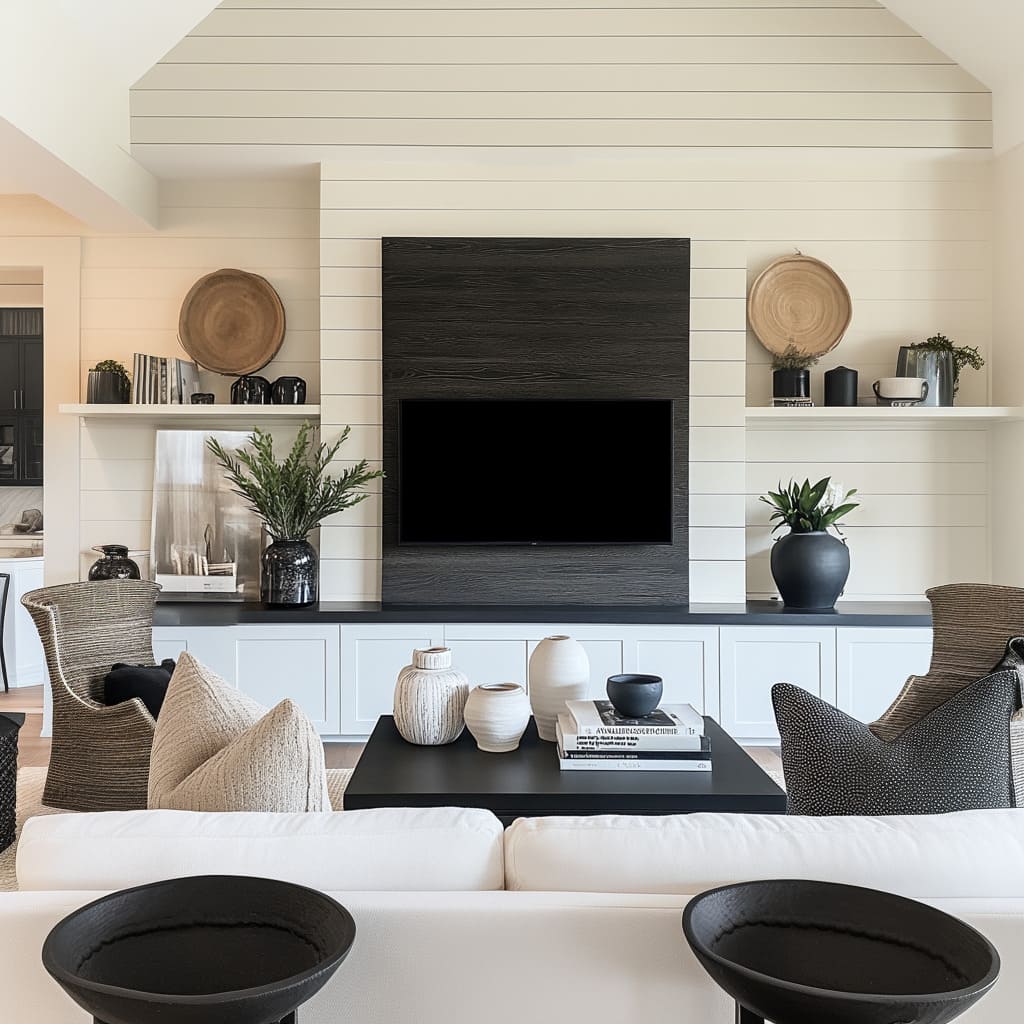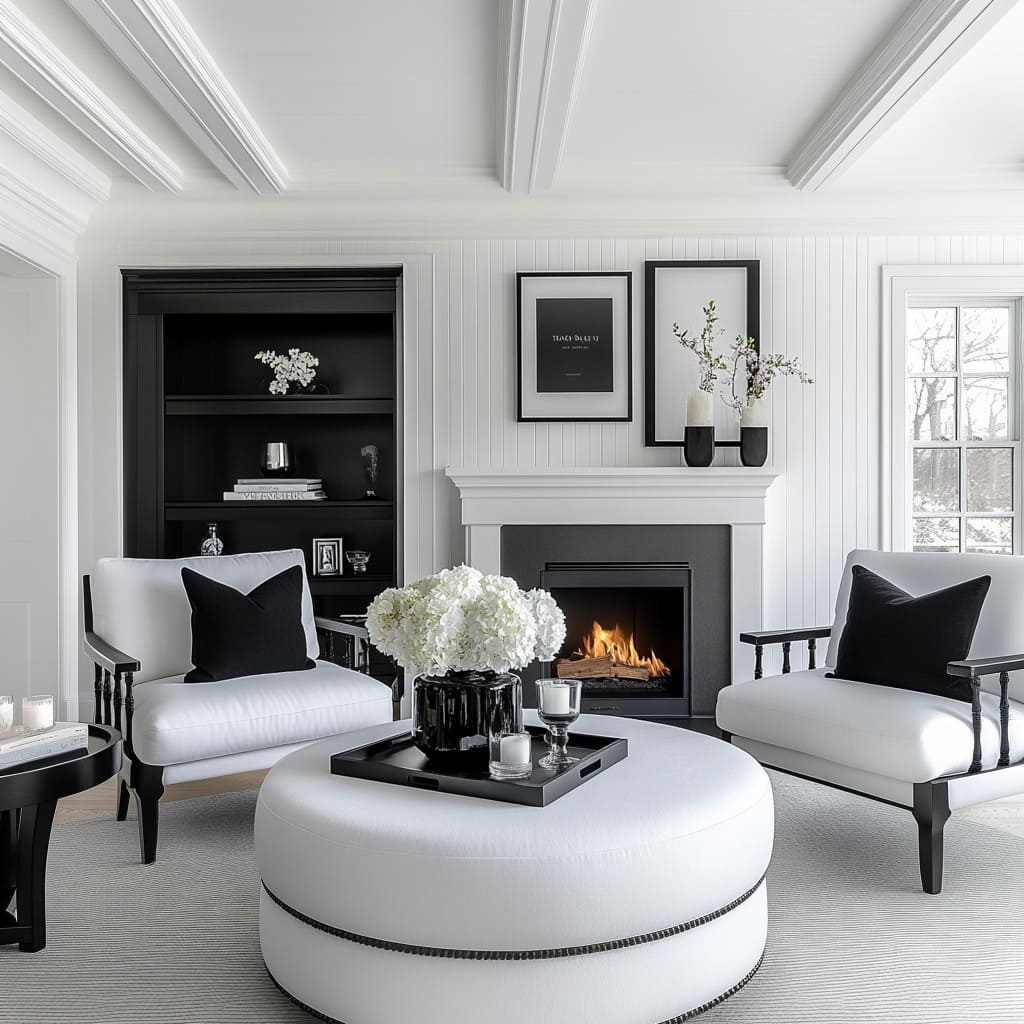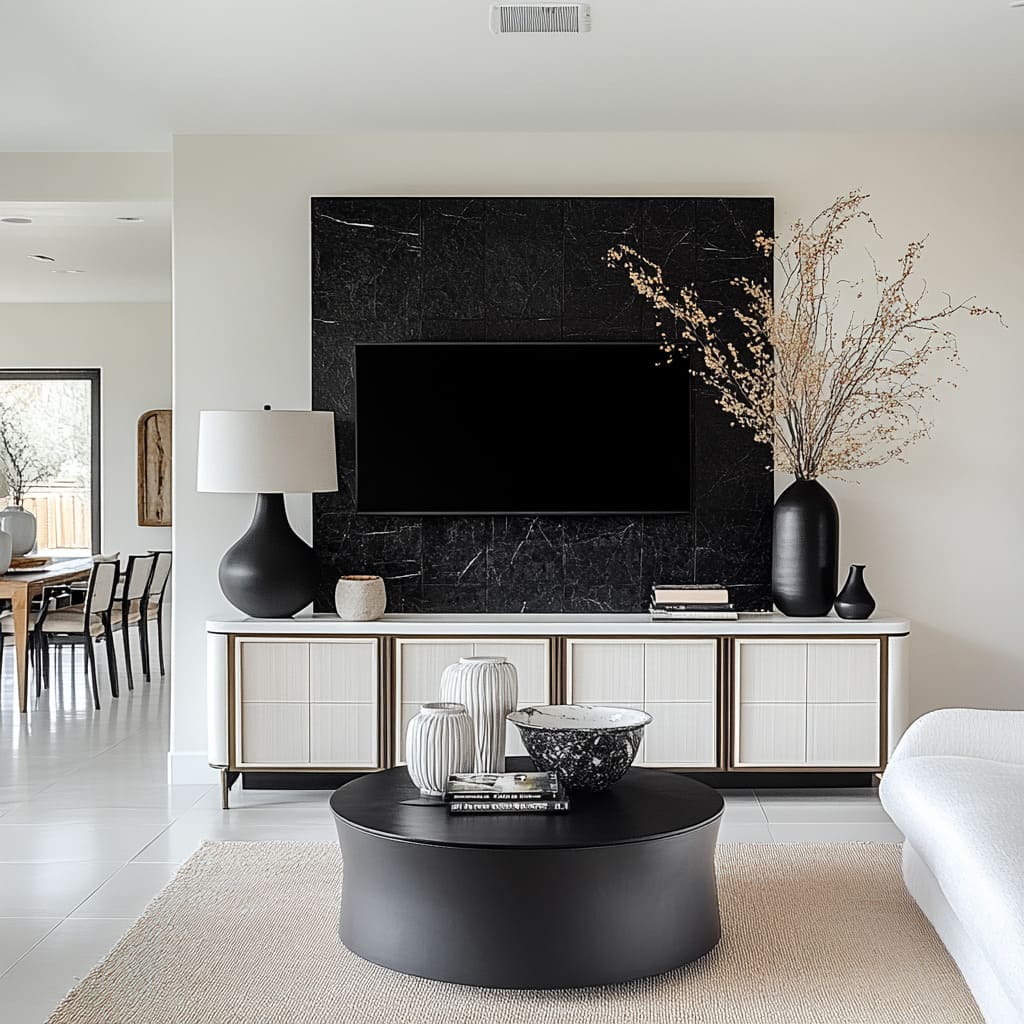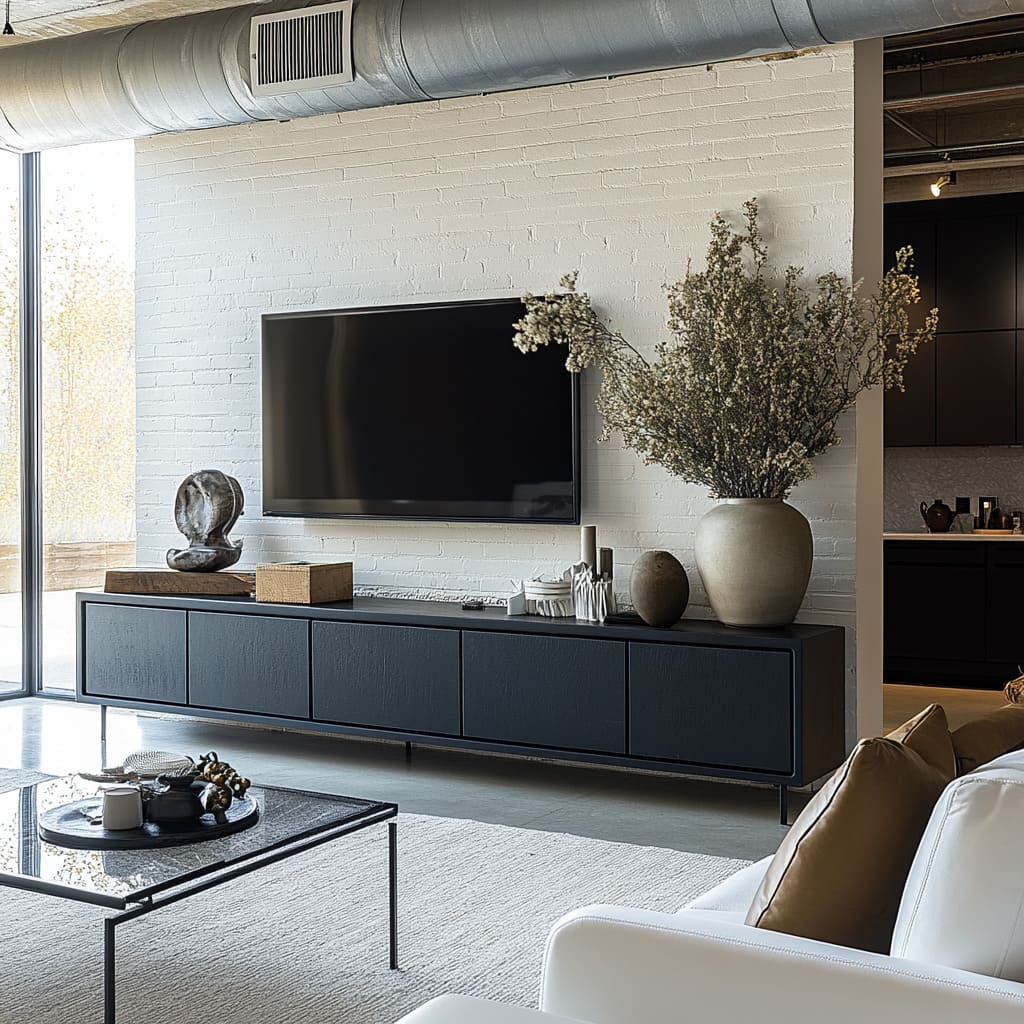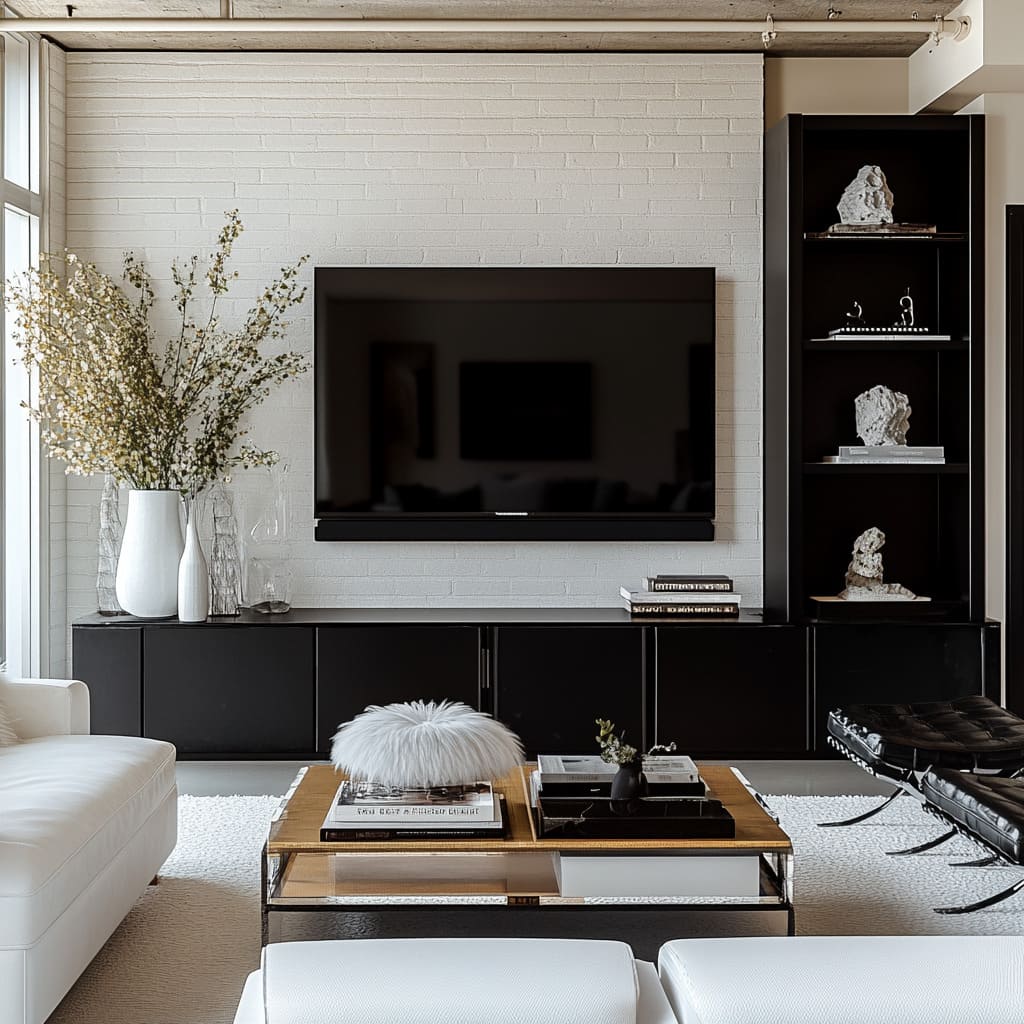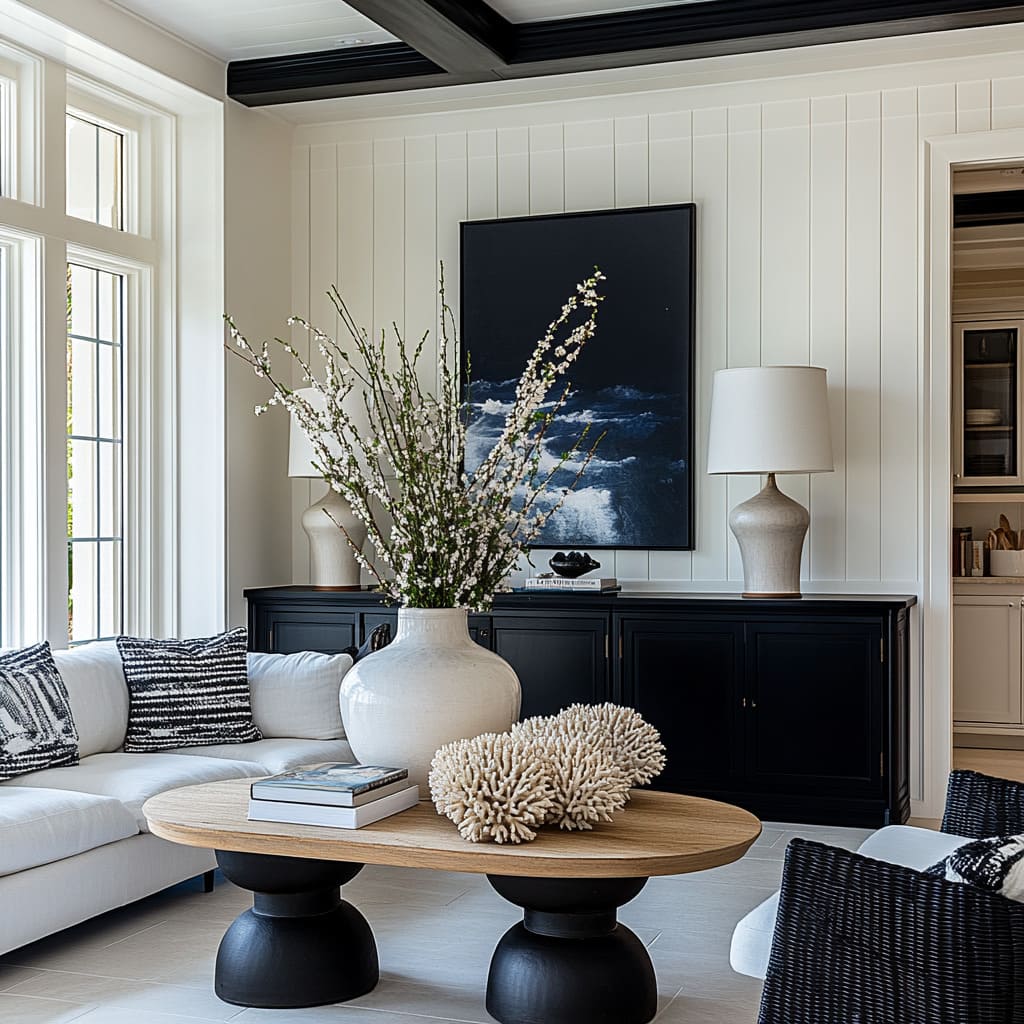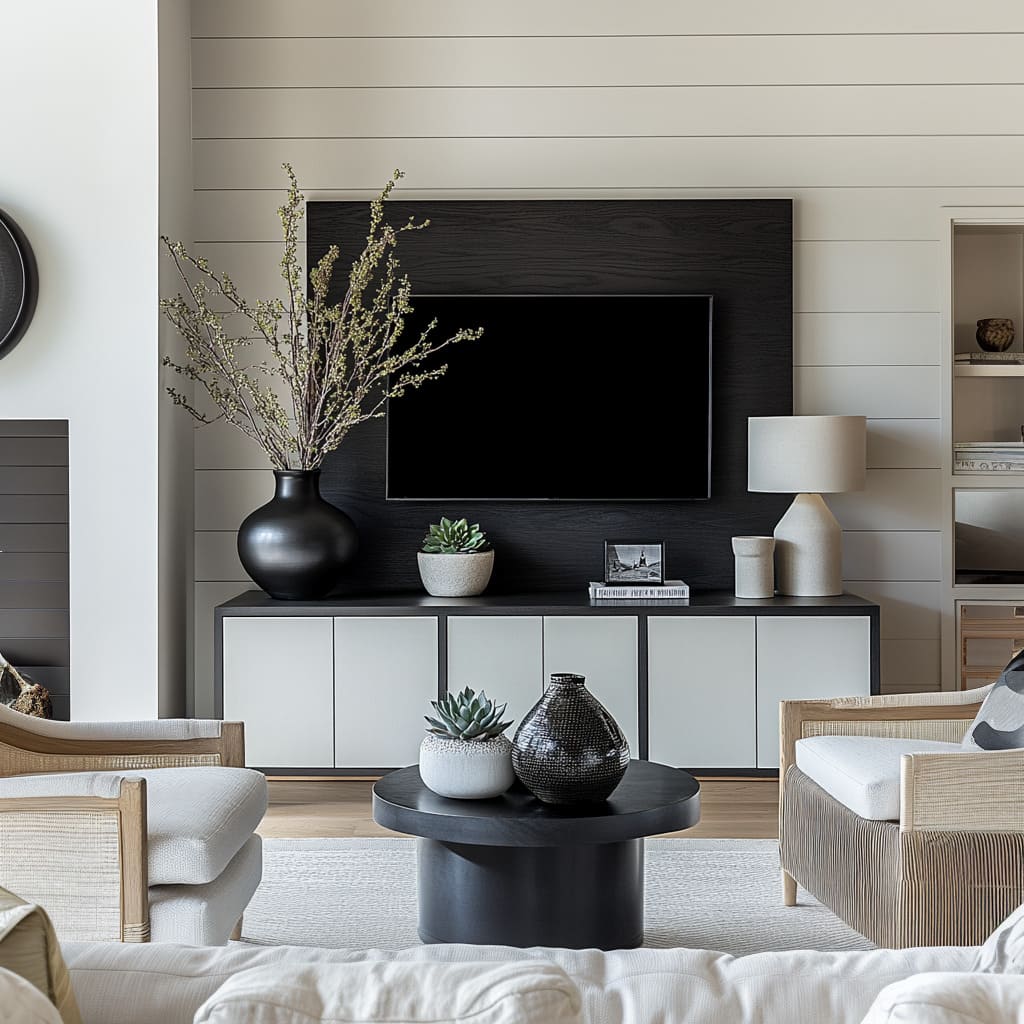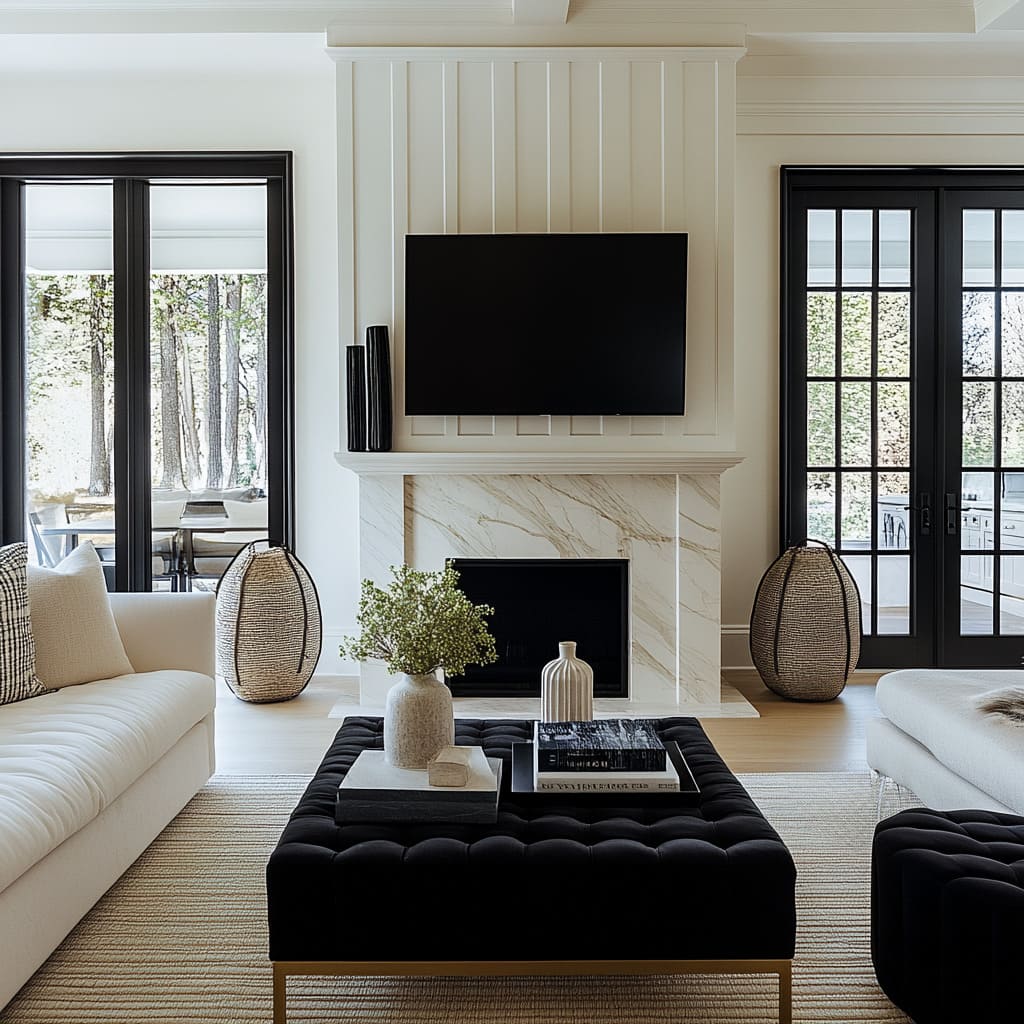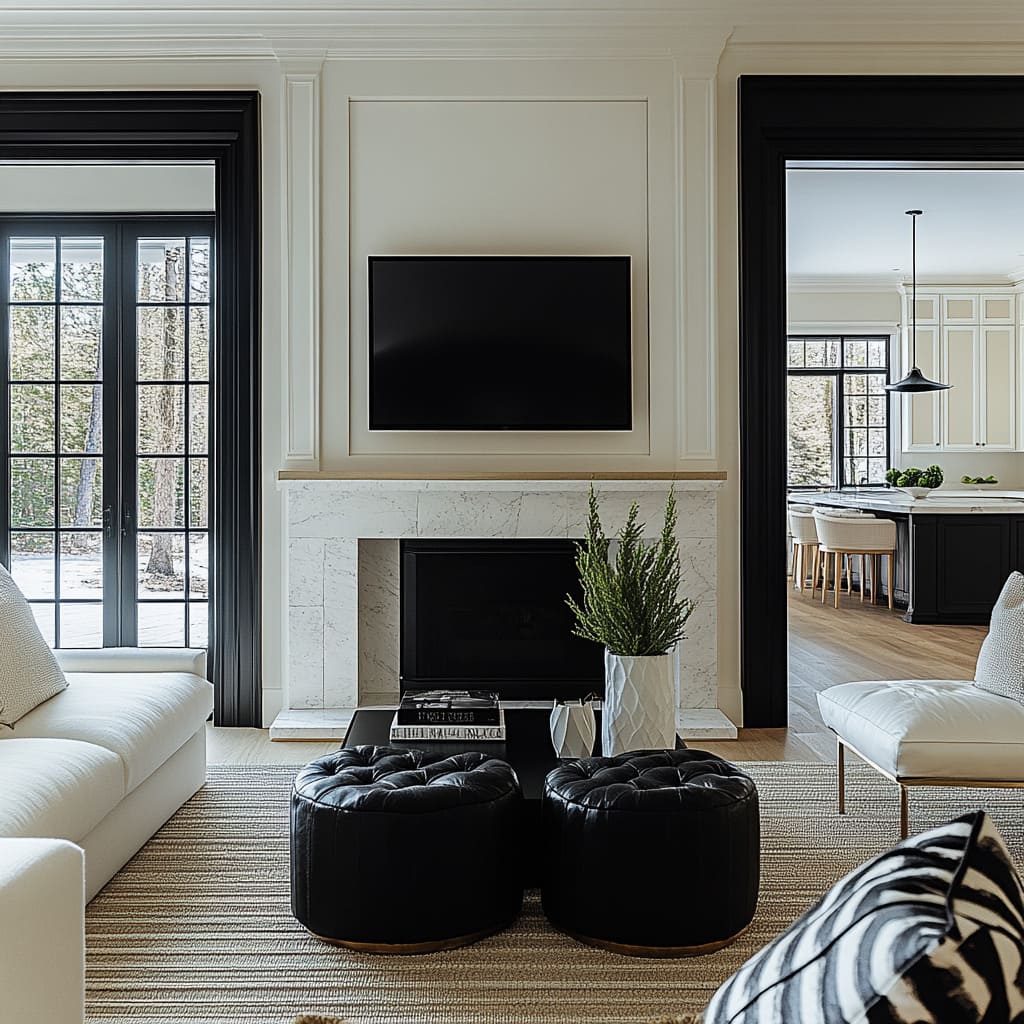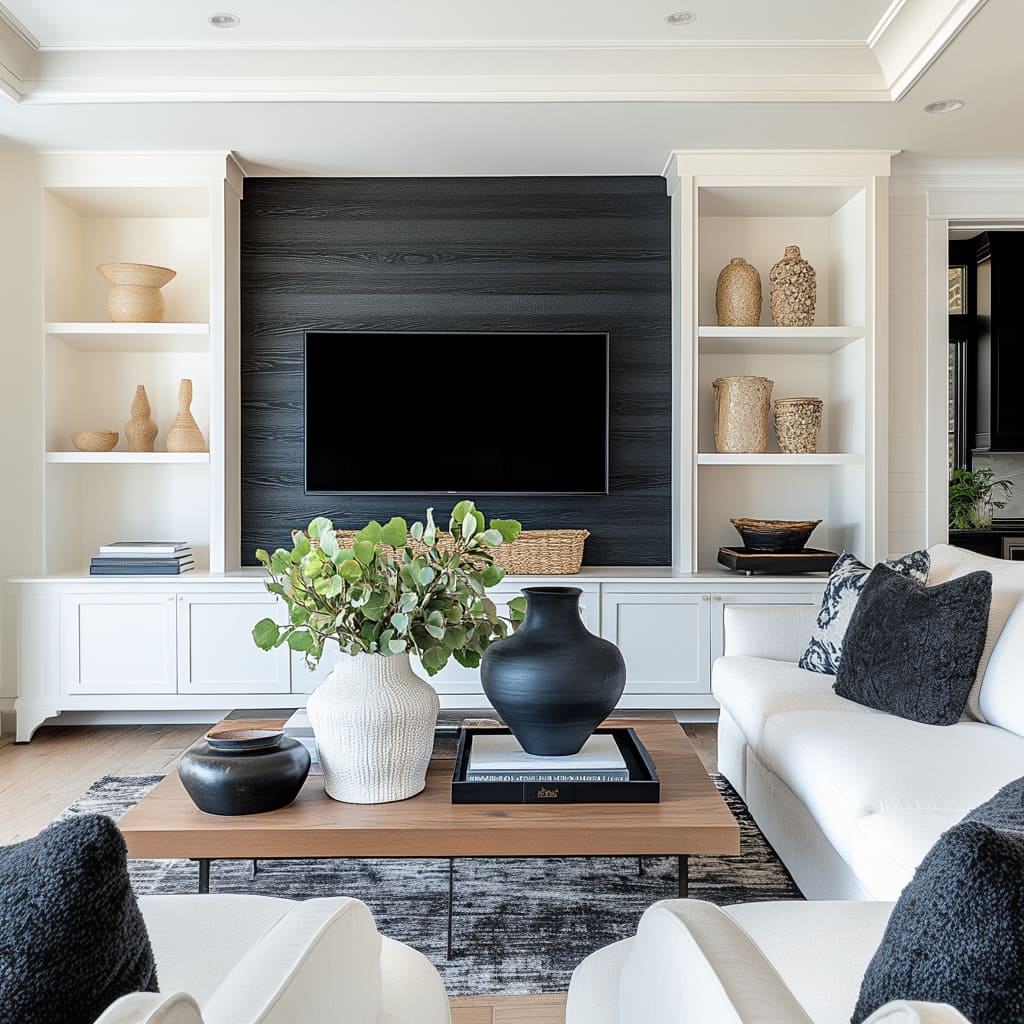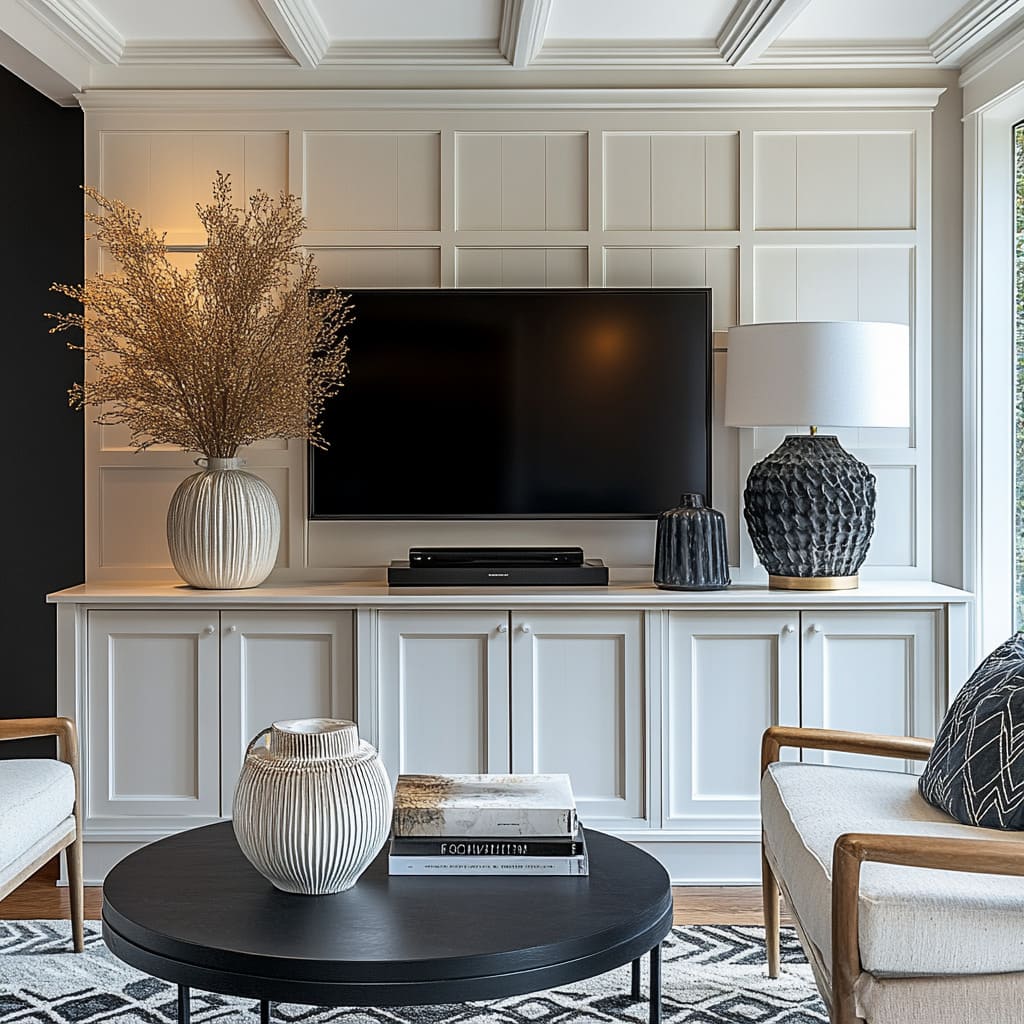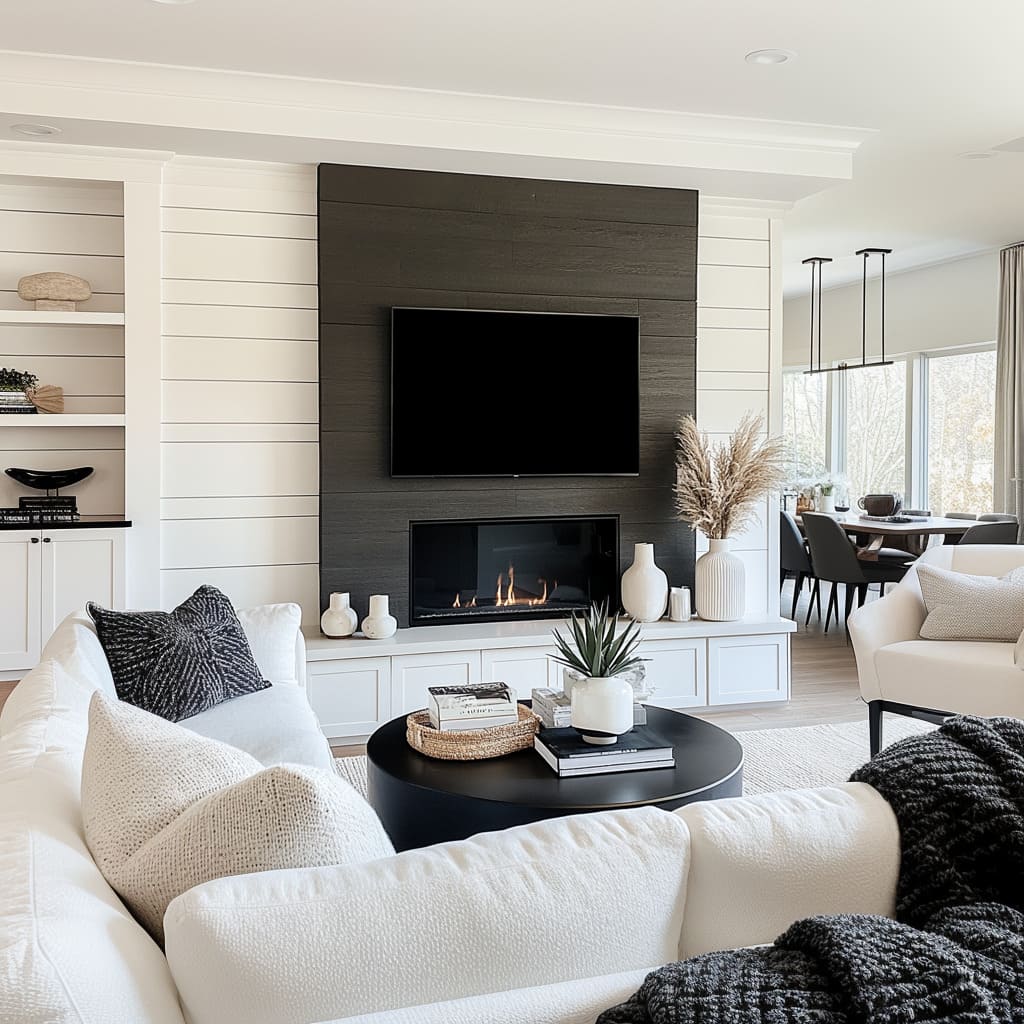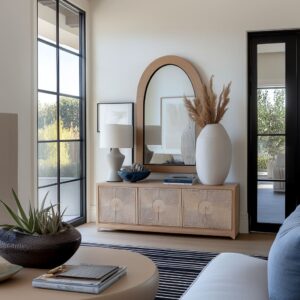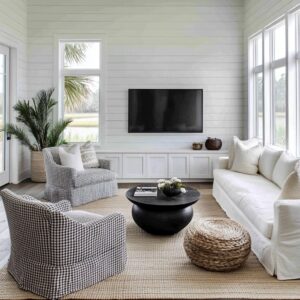A black and white lounge room is more than a timeless design choice—it’s a bold statement of contrast and harmony. These spaces can feel sleek and modern while remaining versatile and inviting, making them a popular choice for homeowners who want to combine style with functionality.
Whether inspired by minimalist Scandinavian aesthetics or sophisticated urban designs, black-and-white interiors offer endless opportunities for personalization.
The secret to achieving this dramatic yet balanced look lies in the thoughtful use of color, texture, and form. From perfectly placed contrasts to carefully chosen furniture and decor, every detail contributes to the room’s overall impact.
In this article, we’ll explore advanced design strategies and principles to help you craft a stunning black and white lounge room that stands out in any home. Whether you’re redesigning a cozy apartment or a spacious open-plan living area, these expert tips will inspire you to create a space that feels both bold and beautifully cohesive.
Color Palette and Balance: Mastering Black and White Harmony
Creating black and white living rooms that feel balanced and inviting starts with a thoughtful approach to color interplay. Rather than thinking of black and white as stark opposites, imagine them as two sides of the same coin, working together to form a cohesive visual flow.
An ideal strategy is to introduce subtle gradients, like soft gray or beige undertones, to soften the transition between the two dominant colors.
Advice
Treat white as your foundation. Walls, ceilings, and larger furniture pieces in white can bring lightness and an expansive feel to the room.
Black, on the other hand, serves as the stabilizing force, adding depth and visual weight through elements like media walls, trims, or statement furniture. This balance avoids overwhelming the senses while keeping the space visually dynamic.
Principle
Think of white as your blank canvas, providing brightness and clarity, while black operates as the grounding element that adds structure and sophistication. To maintain harmony, let each color occupy a defined role in the room.
Schema
Use the ’60-30-10′ guideline to guide your color distribution:.
- 60% white: Focus on walls, ceilings, and large furnishings like sofas to maintain openness.
- 30% black: Introduce this through features like built-in shelving, coffee tables, or trims, anchoring the design.
- 10% accents or natural tones: Add warmth and texture through materials like wood, woven baskets, or small greenery, ensuring the room doesn’t feel too stark or sterile.
Pattern
Black can be used strategically to add rhythm and structure. Consider integrating it in symmetrical layouts, such as grid-style shelving, neatly paneled walls, or modular furniture groupings.
This approach ensures that black feels intentional rather than random, giving the space a sense of order and refinement. By thoughtfully blending these design principles, black and white living rooms can exude a sense of sophistication without sacrificing comfort, making them both visually stunning and livable.
Textures and Finishes: Layering for Depth
A truly captivating black and white living room relies on more than just color—it’s the interplay of textures and finishes that brings it to life. Flatness can make even the best color choices feel uninspired, so layering a variety of tactile materials is the secret to a dynamic and welcoming space.
Advice
Incorporate materials with rich textures to break up monotony and add dimension. Think of a textured black slate media wall that contrasts with the softness of boucle-upholstered white seating.
These tactile elements not only make the space visually interesting but also invite interaction and comfort.
Principle
Strive for harmony by balancing sleek and textured finishes. For example, a glossy white lacquered console table paired with matte black hardware creates a dynamic tension that feels deliberate.
Similarly, consider anchoring the room with a herringbone-patterned monochromatic rug, which subtly adds complexity without disrupting the theme.
Schema
Introduce ‘zones of texture’ to guide your design:.
- Walls: Use textured wallpaper or shiplap panels in neutral tones to add subtle depth.
- Furniture: Combine smooth leather upholstery with boucle armchairs or ribbed fabric sofas to create layers of tactile appeal.
- Accessories: Woven baskets, ceramic vases, or sculptural art pieces placed strategically on tables or shelves provide organic textures that soften the contrast between black and white.
Pattern
Play with contrasting textures within a single color to heighten the room’s visual depth. For instance, pair a polished black coffee table with matte black decor pieces like candleholders or vases.
This creates a layered, tonal effect that elevates the monochrome palette into something sophisticated and multi-dimensional. By weaving together these thoughtful black and white living room ideas, you can create spaces that feel stylish yet approachable.
The use of diverse textures and finishes ensures your living room is full of depth and character, making it a standout example of modern interior design.
Contrast Placement: Controlling the Visual Flow
A successful black and white living room design thrives on the careful placement of contrasts to create a cohesive and visually dynamic space. Strategic use of light and dark tones ensures the room feels intentional and avoids the chaos of unbalanced elements.
Advice
Use contrast as a tool to guide attention and highlight key features. For example, placing a bold black accent wall behind a sleek white media console establishes a natural focal point.
This method directs the viewer’s gaze while maintaining an overall sense of balance. Contrast placement can also establish a hierarchy in the design, making each element feel deliberate.
Principle
Focal points are the ideal locations for strong contrasts. A dark TV wall, a fireplace with black trim set against white paneling, or monochromatic artwork mounted above a sofa can anchor the room.
To avoid overwhelming the eye, keep surrounding areas subdued by incorporating neutral or soft transitional tones.
Schema
Think of contrast in layers to create depth and harmony:.
- Primary Layer: Juxtapose black and white in substantial elements like walls, large furniture, or feature panels. These serve as the foundation of your design.
- Secondary Layer: Add subtle gradients or patterns in items such as area rugs, curtains, or throw cushions. These details soften the contrast while adding visual interest.
- Tertiary Layer: Introduce minimal metallic accents like brass or chrome in light fixtures or table decor to break the rigidity of the black-and-white scheme and add a subtle shimmer.
Pattern
Implement a ‘contrast layering’ approach to maintain balance and flow. Position darker tones closer to the floor, such as a deep black coffee table or a dark rug, and lighten the palette as you move upward.
For instance, mid-tone gray cushions can bridge the black sofa and white walls, while the ceiling remains crisp and bright to emphasize height and openness. This thoughtful application of contrast ensures that your black and white living room design feels both striking and cohesive.
By placing contrasts purposefully and layering them, you create a space where every detail feels interconnected and purposeful.
Furniture Selection and Placement: Proportional Elegance
Choosing the right black and white living room furniture is a critical step in crafting a space that feels balanced and refined. Each piece should contribute to the overall design without overpowering the room or competing for attention.
Advice
Select furniture that aligns with the scale and proportions of your living space. For example, low-profile black coffee tables with sleek finishes pair beautifully with deep, plush white sofas.
This combination offers visual weight while maintaining an open and uncluttered appearance. By avoiding oversized or bulky items, you ensure the furniture complements the room’s dimensions.
Principle
Modular and functional furniture pieces not only enhance flexibility but also support a cohesive design. Sectional sofas are excellent for creating adaptable layouts that can accommodate various needs.
Similarly, nesting coffee tables provide the freedom to adjust arrangements without sacrificing style. The versatility of these elements ensures the room can transition effortlessly between everyday use and entertaining.
Schema
Organize the furniture with a clear and intentional layout centered around a main axis:.
- Begin with a sofa or primary seating to act as the anchor of the room.
- Add a central coffee table in a contrasting finish, such as a glossy black table against a matte white rug or vice versa, to create a striking focal point.
- Incorporate auxiliary seating like woven accent chairs or leather poufs, which bring complementary textures and add functional layers to the setup.
Pattern
Balance symmetry and subtle asymmetry to create a harmonious yet dynamic space. Symmetrical placement, such as mirroring chairs or side tables, establishes a structured flow.
Break this symmetry deliberately with a single, unexpected accent—perhaps a freestanding black lamp or an oversized planter. This thoughtful disruption adds character and keeps the room from feeling too rigid.
By combining proportional furniture, functional layouts, and contrasting finishes, you can design a black and white living room that feels inviting and polished. Carefully chosen pieces and strategic placement create a space where every element serves a purpose and contributes to a unified aesthetic.
Accessories and Decorative Elements: Amplifying Style
The finishing touches in a black and white living room are as significant as the larger design choices. Accessories and decor can define the personality of the space, bringing warmth and individuality without disrupting its minimalist essence.
Advice
Curate accessories thoughtfully to avoid visual clutter. Stick to a select number of impactful items that speak to the refined simplicity of the black and white aesthetic.
For instance, sculptural vases with bold silhouettes, abstract black-and-white artwork, and a touch of greenery offer contrast and texture while staying within the design’s clean framework. By choosing pieces that make a statement, every decorative element earns its place.
Principle
Accessories are an excellent way to introduce softer, organic shapes and natural materials, countering the linearity and precision often associated with black and white schemes. For example, a round ceramic vase or a woven basket adds warmth and tactility, making the room feel more inviting.
This balance of materials enriches the atmosphere and enhances the visual appeal.
Schema
Organize accessories into three distinct tiers for a well-layered look:.
- Large statement pieces like oversized vases, framed art, or even a striking sculpture can become focal points.
- Medium-sized decor such as lamps, stacked books, or decorative boxes serve to bridge the gap between bold and subtle elements.
- Small accents like ceramic bowls, sculptural figurines, or candlesticks add intricate details to complete the composition.
Pattern
Arrange decor in groupings of odd numbers—three or five is a classic choice for creating a balanced yet visually dynamic arrangement. Ensure variation in heights and textures within each grouping.
For instance, pair a tall vase with a shorter stack of books and a medium-sized abstract sculpture to create an engaging display. This layering technique keeps the eye moving through the space while maintaining harmony.
Incorporating these black and white living room decor ideas ensures a design that feels cohesive and stylish. Thoughtful placement, organic shapes, and tactile materials create a refined look while subtly breaking up the starkness of the monochromatic palette.
This approach transforms the living room into an inviting and visually captivating space.
Vertical Design Elements: Enhancing Height and Drama
In a black and white living room, vertical design elements play a crucial role in shaping the perception of space, creating both height and sophistication. Thoughtfully emphasizing verticality can transform even a compact room into one that feels open and grand.
Advice
Utilize vertical surfaces strategically to amplify the sense of height and space. Black-framed windows or tall shelving units not only draw the eye upward but also add a sleek architectural quality to the room.
Pair these with contrasting white elements to enhance the effect. For instance, floor-to-ceiling curtains in sheer or light fabrics, hung from slim black rods, elongate the walls while keeping the room airy.
Principle
Incorporating vertical accents in black, such as paneling, tall light fixtures, or even elongated artwork, introduces drama without overwhelming the room’s proportions. These elements work to visually stretch the space, creating a sense of grandeur and balance.
By grounding the design with horizontal furniture like wide media consoles, you achieve a harmonious interplay of lines.
Schema
Blend horizontal and vertical lines thoughtfully to maintain visual balance and structure:.
- Horizontal elements like low-profile black coffee tables or long console tables anchor the room and ground the design.
- Vertical elements like built-in bookshelves, slim black sconces, or monochrome artwork add height and direct the eye upwards. This interplay ensures that the room feels cohesive rather than chaotic, with each element supporting the overall spatial flow.
Pattern
Introduce functional and stylish vertical features like wall-mounted decor. For example, floating shelves paired with accent lighting not only provide additional storage but also break up wall space dynamically.
Similarly, tall, slim sconces in black enhance the room’s height and add an ambient glow without encroaching on floor space. By combining vertical black accents with light, airy touches, you can achieve a striking balance that emphasizes both height and drama.
These design strategies not only optimize space but also infuse the living room with a refined architectural flair, making it both functional and visually compelling.
Light and Shadow: Subtle Illumination
In a black white living room, lighting becomes a powerful tool to shape the mood and highlight the finer details of the design. The interplay between light and shadow creates depth and enhances textures, making the space feel alive and multi-dimensional.
Advice
Layered lighting is key to controlling how light interacts with the contrasting elements of black and white. For instance, warm LED strips hidden behind black panels or integrated within shelving units can diffuse harsh edges and create a soft glow.
Complement these with ambient floor lamps in white or natural tones to maintain balance while avoiding over-illumination.
Principle
Every light source should have a purpose, whether it’s to accentuate textures, highlight focal points, or provide functional illumination. A recessed spotlight angled toward a matte black wall can bring out its subtle texture, while a carefully placed lamp near a textured white vase draws attention to its form and material.
Lighting not only enhances visibility but also adds a sculptural quality to decor.
Schema
Divide the room into three distinct lighting zones to address different needs:.
- Ambient lighting ensures the room has a comfortable level of brightness, achieved through ceiling fixtures or wall-mounted sconces that blend seamlessly into the design.
- Task lighting provides focused illumination for specific purposes, like a sleek black table lamp for a cozy reading nook.
- Accent lighting emphasizes key elements, such as textured surfaces or decor pieces, using LED strips or directional spotlights to add dimension and visual intrigue.
Pattern
Dimmers are a must for black and white interiors, as they allow the lighting to shift the atmosphere effortlessly. During the day, brighter lighting enhances the crisp contrast between black and white elements, while softer lighting in the evening creates an intimate, cozy feel.
By balancing brightness levels, you can adapt the room’s ambiance to suit any occasion. Thoughtful lighting placement transforms a black white living room into a dynamic space that feels welcoming yet sophisticated.
By embracing the nuanced relationship between light and shadow, you bring out the best in the room’s textures, focal points, and overall aesthetic.
Natural Elements and Greenery: Softening the Contrast
Incorporating natural elements into black and white front room ideas adds warmth and life to an otherwise structured space. Plants and natural textures serve as a bridge between the crisp contrasts of black and white, creating a more inviting and balanced interior.
Advice
Use plants and organic materials to soften the sharp lines and bold contrasts inherent in a monochrome palette. A tall black vase filled with olive branches or a light jute rug beneath a sleek coffee table can subtly introduce texture and warmth without disrupting the overall aesthetic.
These elements ensure the space feels welcoming, not overly rigid.
Principle
Nature-inspired accents bring fluidity to a design defined by strong geometric lines. Architectural plants like fiddle leaf figs, snake plants, or olive trees fit seamlessly into clean, modern spaces while adding depth and vibrancy.
These organic forms contrast beautifully with the monochrome palette, offering a natural antidote to its sharpness.
Schema
Select greenery and natural textures that align with the overall aesthetic of the room:.
- Plants: Opt for architectural varieties with defined shapes that echo the room’s linear designs. For example, a fiddle leaf fig placed in the corner or an olive tree near the seating area can enhance the verticality of the space.
- Accessories: Pair plants with black or white pots to ensure they integrate smoothly into the palette. Neutral-toned woven baskets or planters can add an additional layer of texture without overwhelming the design.
Pattern
Place greenery in key areas to create a cohesive and visually engaging flow. For example, position a tall plant in a corner to fill negative space and smaller potted plants on shelves or side tables to complement decorative elements.
Use varying heights and pot sizes to add dimension while keeping the overall look balanced. By integrating natural elements thoughtfully, you can transform stark black and white front room ideas into spaces that feel alive and approachable.
Plants and organic textures don’t just soften the contrast; they add a sense of movement and energy that makes the room feel complete.
Composition Principles: Layering and Rhythm
A well-executed black and white living room theme relies on the artful layering of textures, colors, and shapes to achieve a space that feels cohesive yet dynamic. Layering is not just about piling on elements but about creating depth and rhythm that draw the eye naturally through the room.
Advice
Start with a structured approach to layering. Begin with foundational pieces like walls, the main sofa, and a rug to establish the base of the design.
Build upon this foundation by adding secondary pieces, such as tables or shelving, and finish with smaller decorative accents. This step-by-step method ensures that the room doesn’t feel chaotic or overcrowded.
Principle
Create ‘design rhythm’ by repeating key elements, like patterns or colors, across different features. For example, if you incorporate a textured black rug, echo its design in the pattern of a throw pillow or a decorative vase.
These subtle repetitions provide visual continuity without making the design feel repetitive.
Schema
Layer elements in a deliberate sequence:
- Foundation: Anchor the room with large-scale elements like the walls, a statement sofa in black or white, and a monochromatic rug to tie the space together.
- Secondary Elements: Introduce medium-scale items such as a coffee table, shelving units, or accent chairs. Ensure these pieces either contrast or complement the foundational elements in terms of color and texture.
- Accents: Add smaller details such as sculptural vases, framed artwork, and plants. These accents bring personality and soften the stark contrast inherent in a black-and-white palette.
Pattern
Use the concept of a ‘visual triangle’ to guide the arrangement of decor. Position a large black piece, such as a media console or floor lamp, in one corner.
Place a white element, like an armchair, diagonally across from it. Complete the triangle with a neutral or textured item, such as a woven basket or a beige planter, at the center.
This approach balances weight and ensures the design feels visually anchored. By carefully layering and maintaining a rhythm, your black and white living room theme will feel cohesive, inviting, and thoughtfully designed.
Each layer contributes to the overall harmony of the space, ensuring that every element, big or small, serves a purpose.
Breaking Monotony: Introducing Surprising Elements
A black and white interior thrives on balance and contrast, but without a touch of the unexpected, it can risk feeling too predictable. Breaking monotony with a standout feature elevates the space while keeping the overall design polished and cohesive.
Advice
Choose a single surprising element that disrupts the uniformity of the room in an intentional way. This might be an abstract art piece with bold lines, a statement chandelier with sculptural details, or even a textured black wall that stands apart from the rest of the space.
These elements should feel like deliberate additions rather than afterthoughts, drawing attention without overpowering the design.
Principle
The surprising element should act as a focal point that contrasts the dominant black-and-white palette while staying within its boundaries or complementary tones. For example, a geometric marble coffee table with veins of soft gray provides visual interest while enhancing the monochrome scheme.
Schema
Create these focal points using one or more of the following approaches:.
- Unique furniture shapes: Opt for curved sofas, angular armchairs, or geometric tables to introduce unexpected silhouettes into the space.
- Bold patterns: Use striped throw pillows, a herringbone area rug, or an eye-catching patterned curtain to add depth and variety.
- Textural contrasts: Pair smooth marble surfaces with rough stone planters or sleek lacquered furniture with woven textiles to create layers of intrigue.
Pattern
Limit surprising elements to one or two per room to maintain a sense of cohesion. For instance, a statement light fixture might pair with a bold piece of artwork, while the rest of the space remains clean and understated.
This ensures that the focal points feel deliberate and well-integrated rather than competing for attention. Adding a surprising element can transform a well-designed black-and-white living room into a space that feels uniquely yours.
With a careful balance of cohesion and individuality, you’ll create an interior that is both visually striking and delightfully unexpected.
Conclusion
Designing a striking black and white living room relies on more than just the contrast of colors. It requires careful balancing of textures, proportions, and lighting, as well as strategic placement of decor and furniture.
By adopting principles like symmetry, layering, and natural accents, and integrating unexpected elements for intrigue, you can create a sophisticated yet welcoming space. These strategies combine the artistry of design with practical insights to achieve interiors that are not only beautiful but also functional and timeless.

